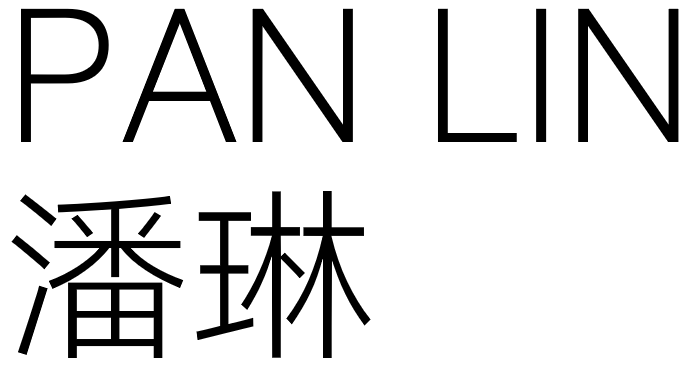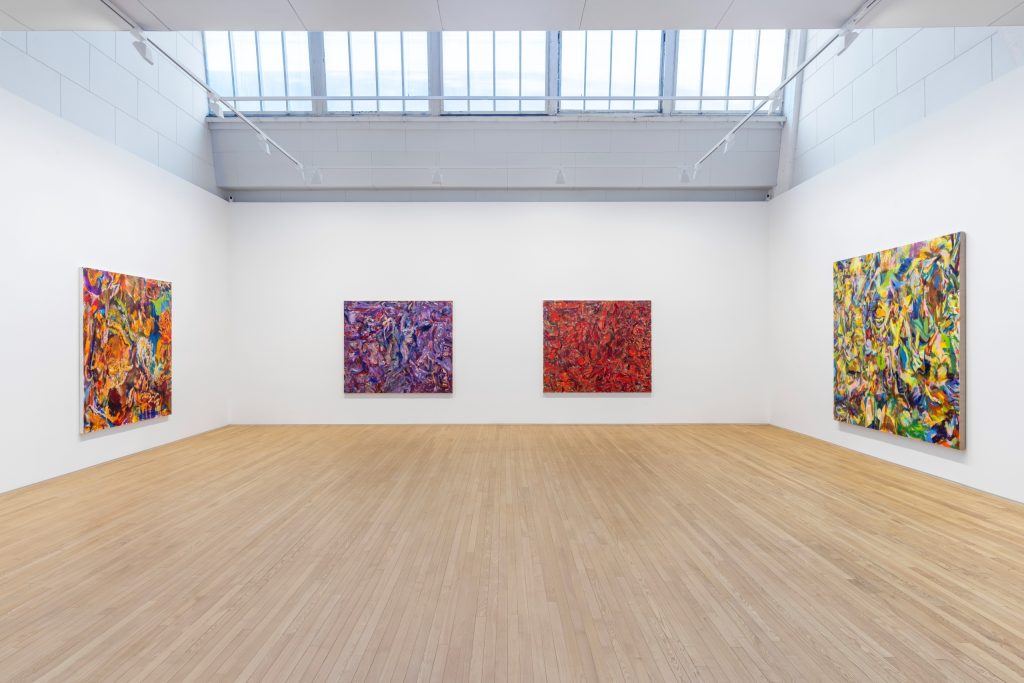
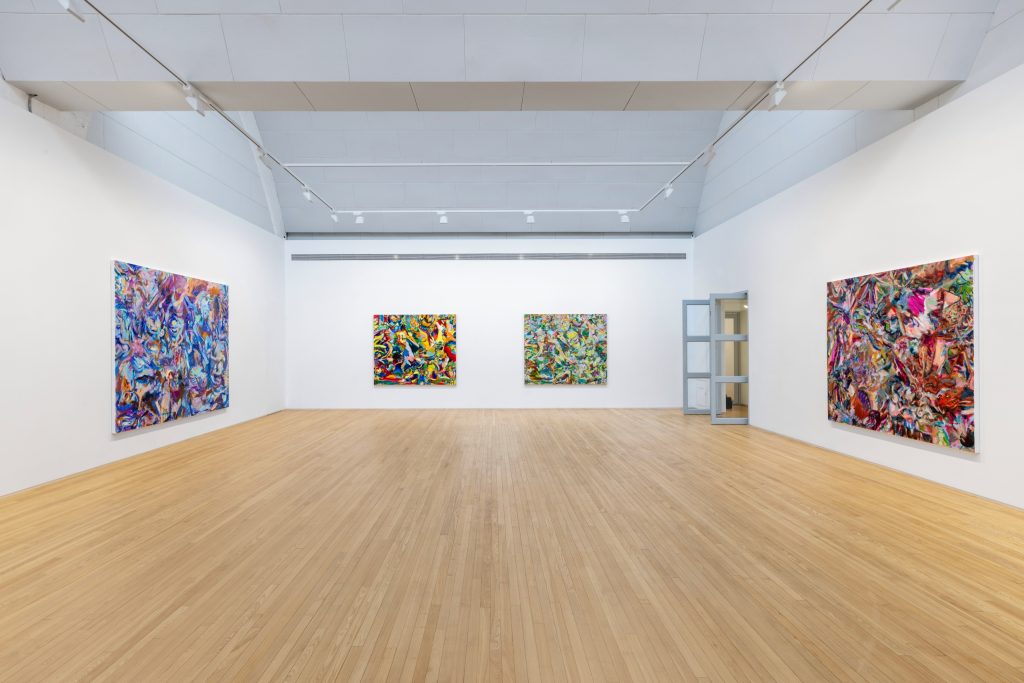
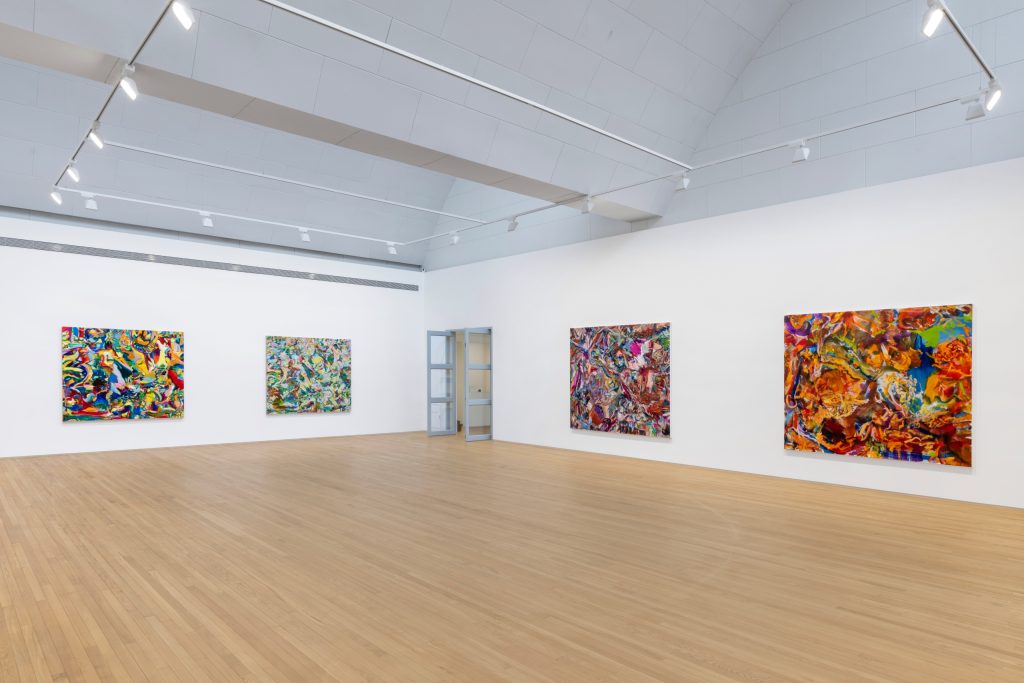
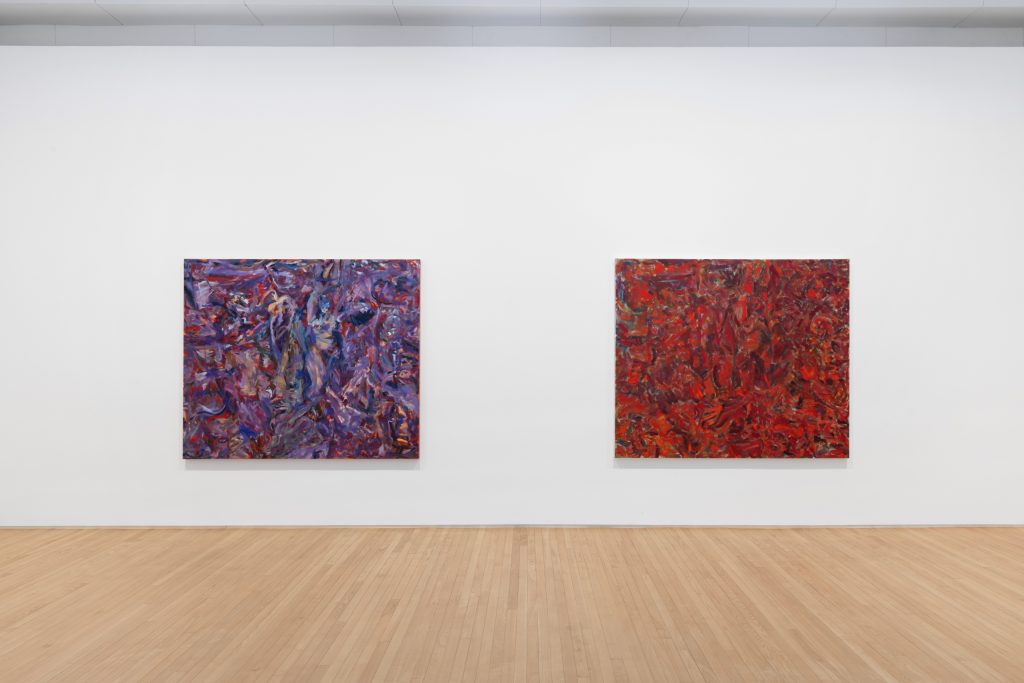
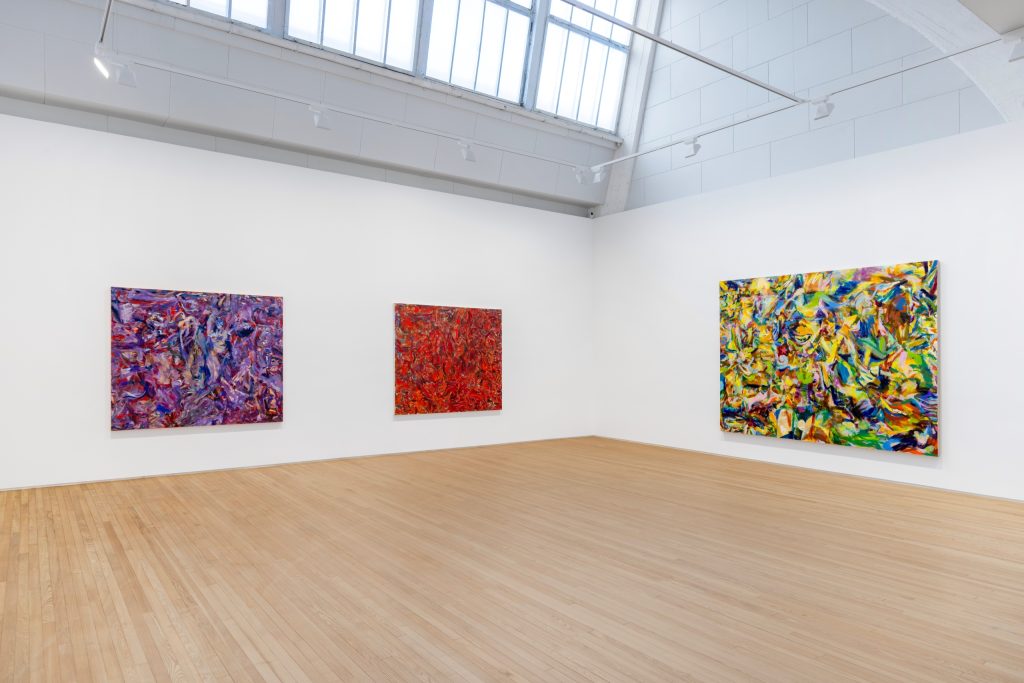
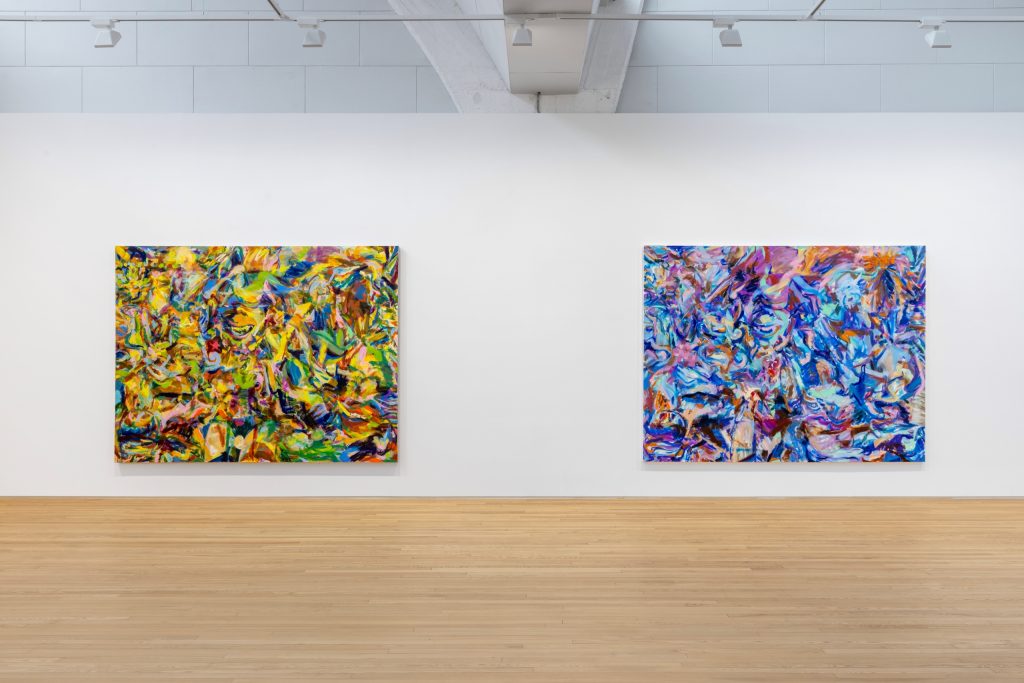
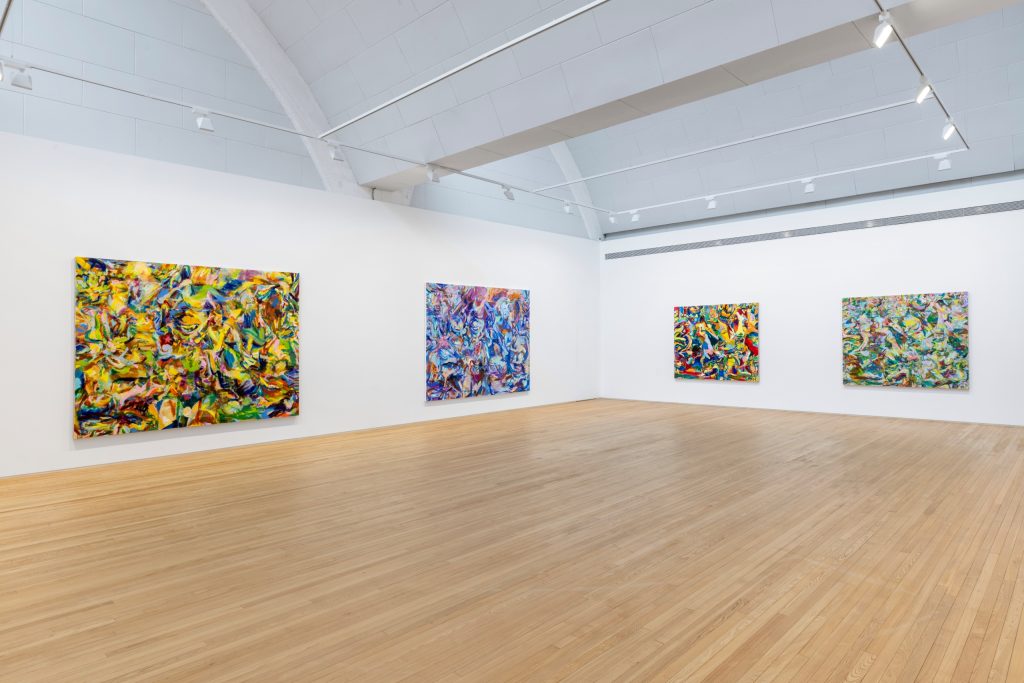
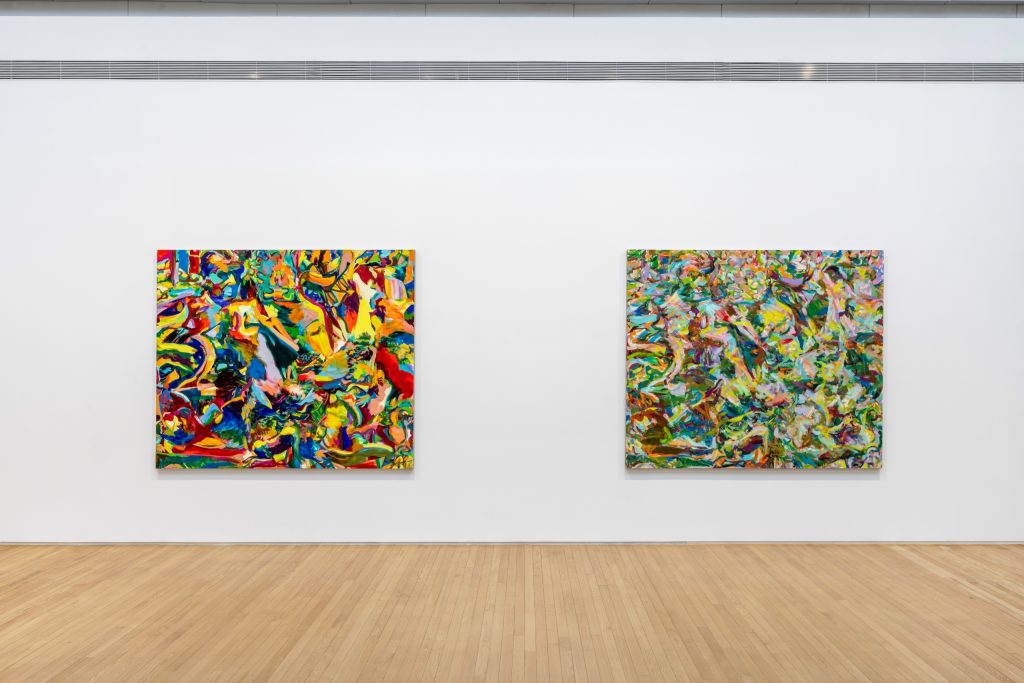
The Colossus, Star Gallery, Beijing
巨神象,星空间,北京,2024
We are pleased to announce Pan Lin’s second solo exhibition at Star Gallery, titled The Colossus, showcasing the artist’s latest creative developments. The exhibition will run from August 31 to October 9.
The exhibition takes its name from the poem “The Colossus” by American poet Sylvia Plath. In this evocative work, Plath uses the image of a massive, time-worn statue, partially buried and eroded, as a metaphor for her complex relationship with patriarchal legacy and the grand tradition of poetry. Through repeated readings of the poem, Pan Lin found deep resonance with Plath’s themes. Having studied painting since childhood, Pan once saw art as her closest companion and sole refuge. Now, with an increasing sense of purpose in her work, this is reflected not only in the visual richness of her paintings but also in a more profound understanding of her relationship with art. Much like Plath’s attempt to clear the silt from the statue’s throat to bring forth its inner space, Pan constantly pushes her work towards the unknown, seeking to convey a comprehensive sensory experience.
This evolution naturally aligns with Pan Lin’s recent experiments in her painting methods, in incorporating her experiences with poetry. Although her paintings may appear straightforward and expressive, they are far from spontaneous creations. Instead, they are shaped by a series of self-imposed creative rules. These rules serve two purposes: first, they act as a safeguard against the artist’s tendency to indulge in her aesthetic habits, using techniques like drawing lots or reading poetry to determine the colors for her collaged drafts. Second, they allow Pan to embark on an inward journey of exploration, bridging the gap between heightened sensory awareness and an open-ended search for her unknown self. In this process, the selection of poetry parallels the inspiration behind her collaged drafts, with repeated readings and recitations awakening personal emotional memories, ultimately forming a deeper understanding of the poetry. This understanding reflects the artist’s inner relationship with the external world, compressing her personal experiences into a contraction that she then reintegrates into her paintings. The final visual results retain certain recognizable forms but fundamentally break free from narrative constraints, leaving viewers with only fragmented visual clues and a sense of dynamic energy. This approach preserves space for the viewer’s own emotional response, as the artist’s engagement with the work becomes more nuanced and indirect. Unlike action painting, which directly exhibits the traces of the artist’s physical presence, Pan’s work is a process of internal alchemy, blending clarity and obscurity within her perceptions. This method closely resembles what Deleuze refers to as the “contemplation of the mind,” allowing the artist to transcend previous compositional rules and use the basic grammar of painting to obscure personal narratives. Once a story begins to be told, the subject inevitably becomes defined and fixed. However, rather than emphasizing the subject, Pan Lin is more concerned with expressing the interconnected synesthetic experiences and the underlying spirituality, which constantly tend towards change and escape.
In the exhibition space, it doesn’t matter if viewers can’t identify the hidden poems of Dylan Thomas within the paintings. What they can recognize is the different variations born from the same collaged draft, each still standing as an independent painting. Much like how a musical piece can be performed in various ways or how a recipe can be interpreted differently across regions, it is often the unpredictability and variability of sensory experiences that bring us the most delight. Though these paintings might seem to come in pairs, their potential for endless variations means that they are not finite in number. There is no eternal truth here, only a vivid, momentary contemplation of life. In this moment, Pan Lin faces the colossus, attempting to capture the fluidity of life on a two-dimensional surface.
Introduction by Yao Siqing
我们欣然宣布将举行潘琳在星空间的第二次个展:巨神像(The Colossus),以呈现艺术家最新的创作动态和艺术进展,展期从8月30号持续至10月9号。
展览名为“巨神像”,其灵感来源于美国女诗人西尔维娅·普拉斯(Sylvia Plath)的同名诗作。在这首动人的诗篇中,诗人以一尊历经时光摧残后破损且半被掩埋的巨大雕像为喻体,来指涉她自己与父权制遗存/伟大诗歌传统之间的复杂关系,以及自己在这一过程中所逐渐意识到的创造者使命和主体性。在反复阅读诗歌的过程中,潘琳找到了深刻的共鸣。自幼习画的潘琳,曾经将绘画视为自己人生路上的亲密伙伴、唯一不能失却的庇护所;而今,随着创作状态的日渐自觉,这既呈现为画面上的视觉丰沛,也令她对自己与艺术的关系有了更强烈的体认和定位,恰如普拉斯为巨神像清理喉管的淤泥、使其内部空间到来一般,潘琳也总是从自己想画的画面一再驱向于未知的边缘,谋求感受力的综合传递。
这一变化,极其自然地契合着潘琳近期在绘画方法上的新试验,那就是诗歌阅读体验的加入。潘琳看似直截淋漓的画面,实际上并不是一挥而就的,而是经历了一系列她给自己制定的创作规则:这些规则一方面是对艺术家沉溺于自己的审美惯性的预防机制,比如以抽签或阅读诗歌的方式来为拼贴的底稿赋予色彩;另一方面,则使艺术家能够经历一个向内探寻的深入过程,从而在感官感觉的敏锐性和主体向未知自我的开放性探索之间,搭设起桥梁。在这一过程中,对诗歌的选择经历了和拼贴出底稿相似的灵感拂动,进而在对诗歌的反复阅读和背诵中,同时也调动起私人的情感记忆,最终形成对诗歌的理解,这一理解能够映照出艺术家与外界事物的内在,并将个体经验以一种凝缩(contraction)的形式返置入画面。在最终的视觉结果上,潘琳的画面保留了若干形象,但在根本上仍然是挣脱了叙事性的线条、色彩与空间关系,仅仅留给观者一鳞半爪的视觉化线索以及涌动的能量感,但这正好也是对观者自由挥发感性的空间予以保留。在这些画作中,艺术家的感性参与,在绘画的过程中被拉得更加细腻且迂回,并不像行动绘画一样直接地呈现出身体的痕迹,而是以自己的内在性为丹炉去进行熔炼和提取,将知觉的清晰和浑然时刻一并保留下来,这种方式非常接近德勒兹所说的“心灵的静观”,既使得艺术家得以从此前的格子或斜线的构图法则中越过,也使得绘画的基本语法在此承担了隐去私人叙述的功能。一旦开始讲述,那个发言的主体必然被刻画和定型,但相较于彰显主体,潘琳更在意地是表达那些相互串联的通感和背后的精神性,它们总是趋向于变化与逃逸。
在展厅中,观者难以辨认出其中隐藏了数首狄兰·托马斯(Dylan Thomas)的诗作并无大碍,观者可以辨认出同一个拼贴底稿诞生出不同的变体,但它们也仍然是一张张独立的绘画,恰如同一曲谱经历了不同的弹奏,同一食谱经历了不同地区风物的演绎,往往是感官的不确定性和变数才为我们带来可观的惊喜。潘琳这些似乎是成对绘制的画作,实际在数量上也可以趋于无穷。因为此处并不存在什么永恒不变的真理,只有凝缩为此刻的、活泼泼的生命观照。潘琳此刻面向了巨神像,是试图将生命本身的流动性,精湛地留存在平面上。
撰文/姚斯青
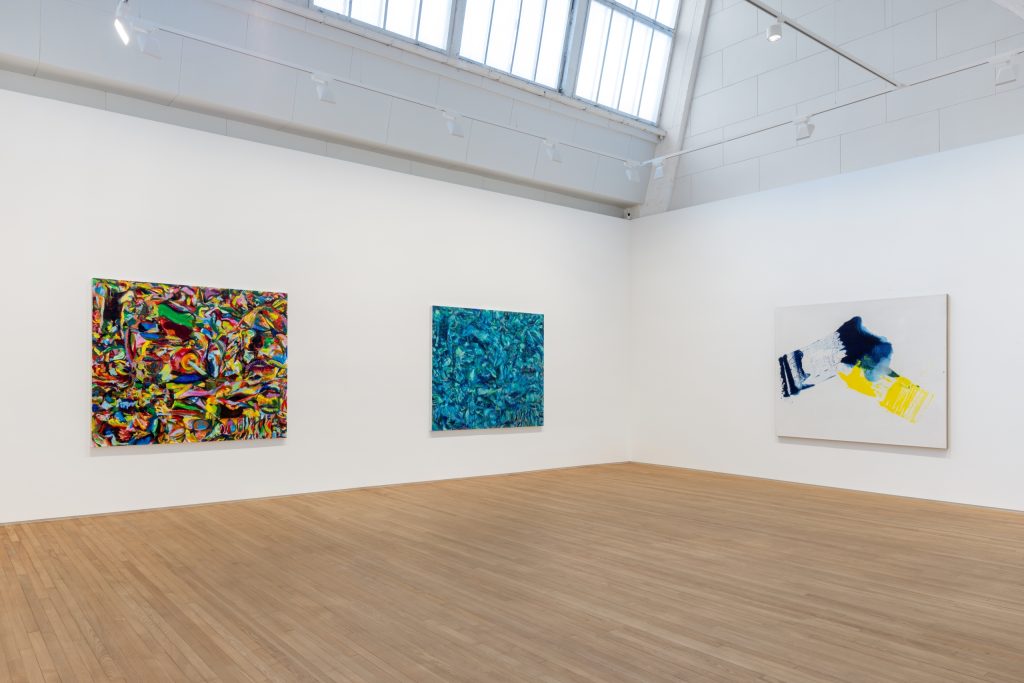
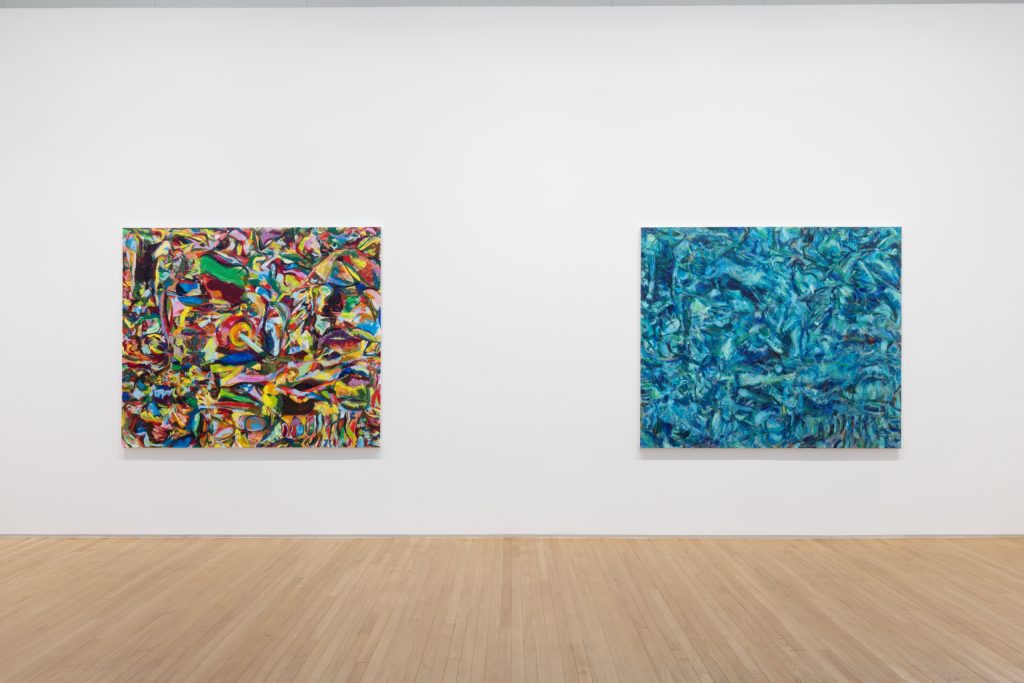
Recent Works,Star Gallery, Beijing, 2024
群展《近作》,北京,星空间,2024
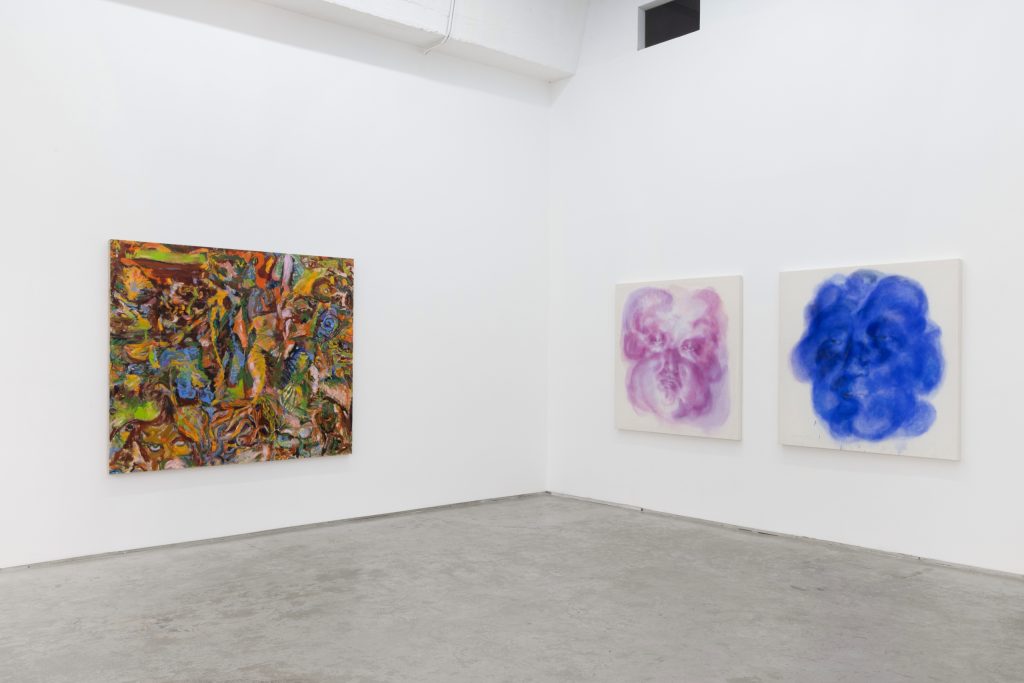
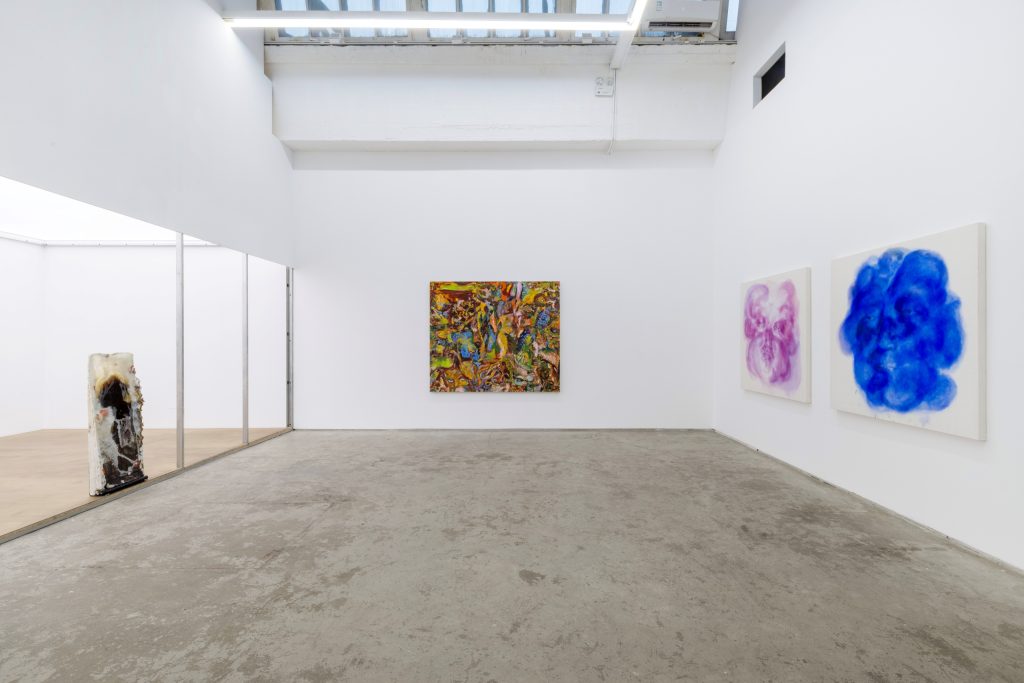
The Enlightenment, CLC Gallery Venture, Beijing
偏见之明,CLC画廊,北京,2024
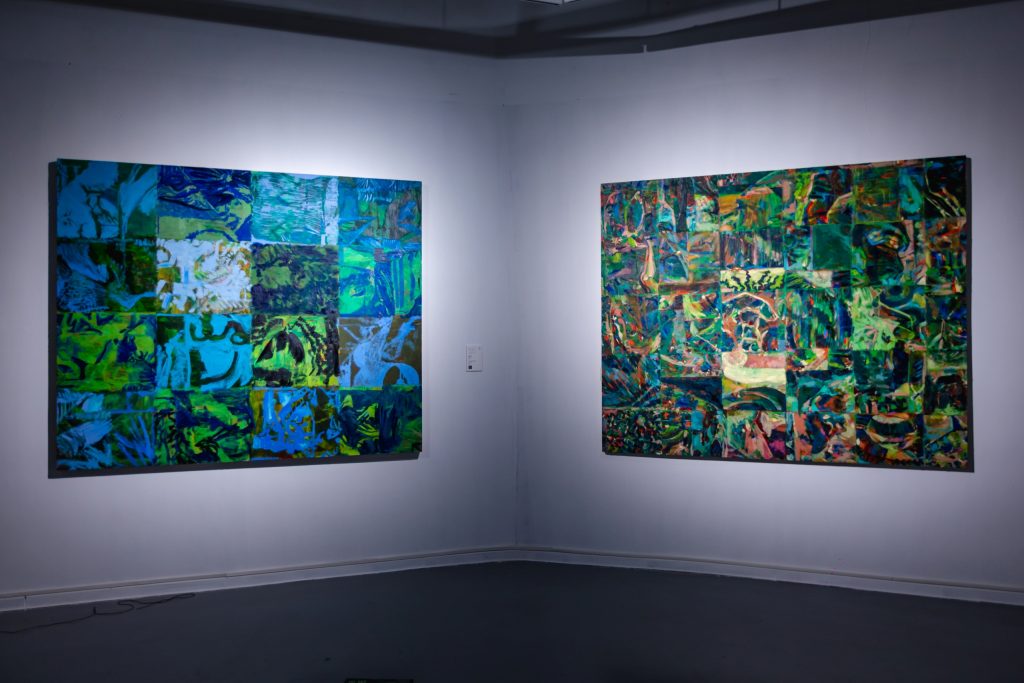
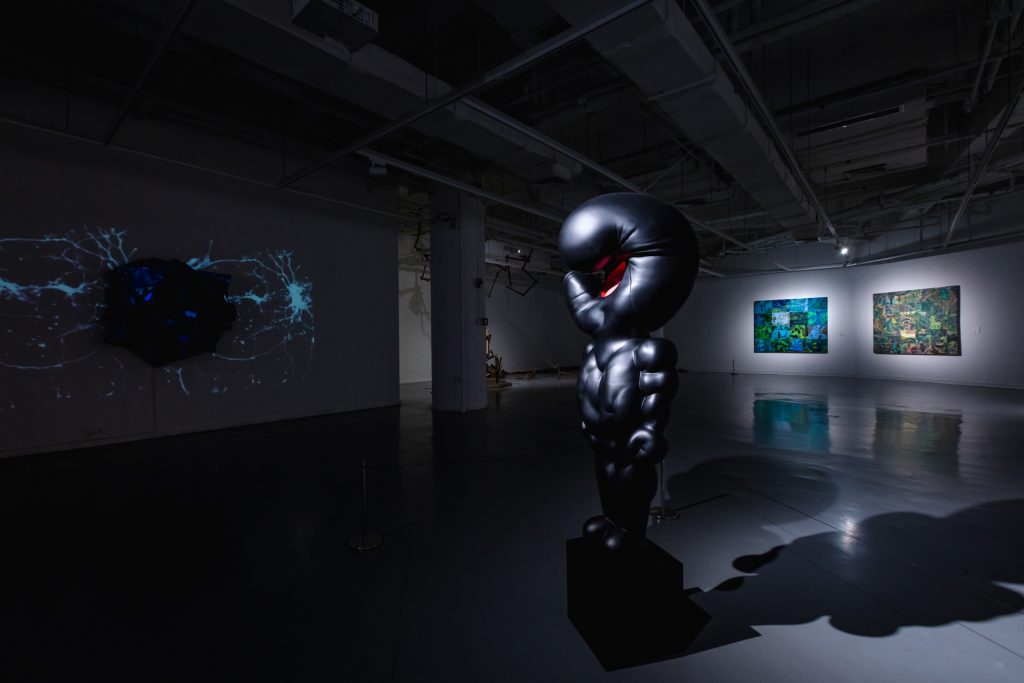
The Eye’s of Wisdom, Contemporary Women Art Exhibition, Suzhou Jinji Lake Art Museum, Suzhou
智慧之眼-当代女性艺术展,金鸡湖美术馆,苏州,2024
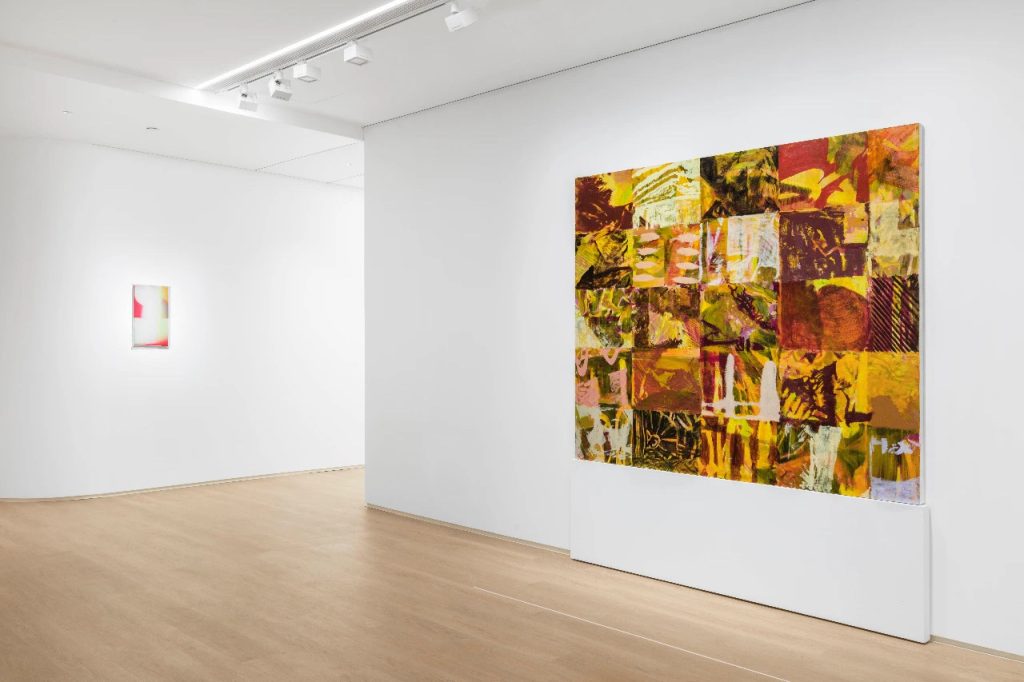
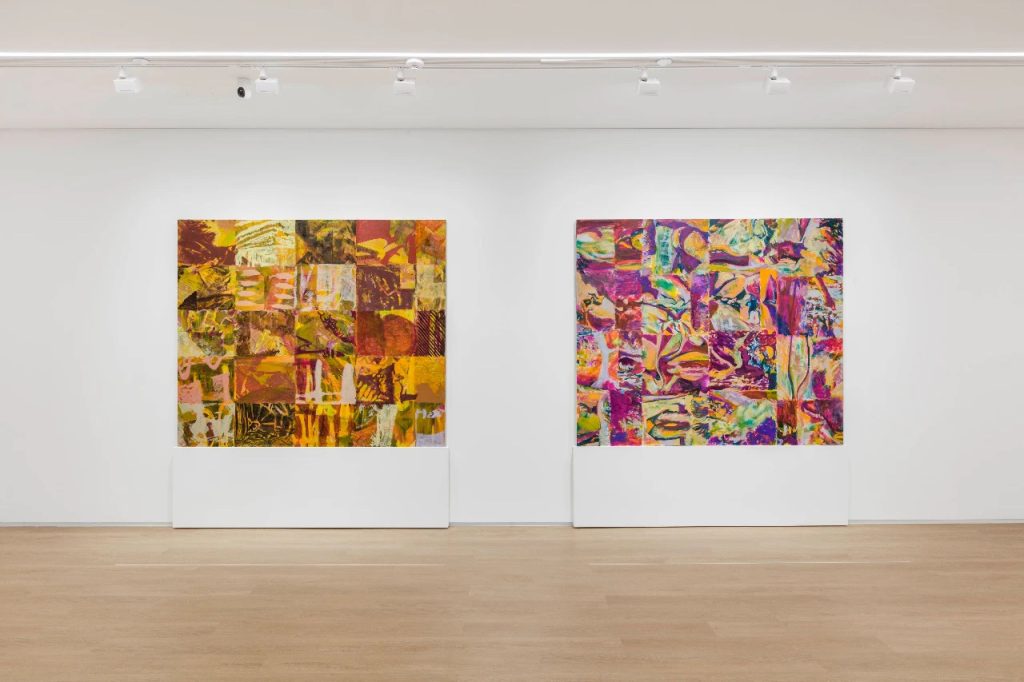
Kong-fu: Form and Meaning, Yuan Art Museum, Beijing
Kong-Fu元美术馆,2023
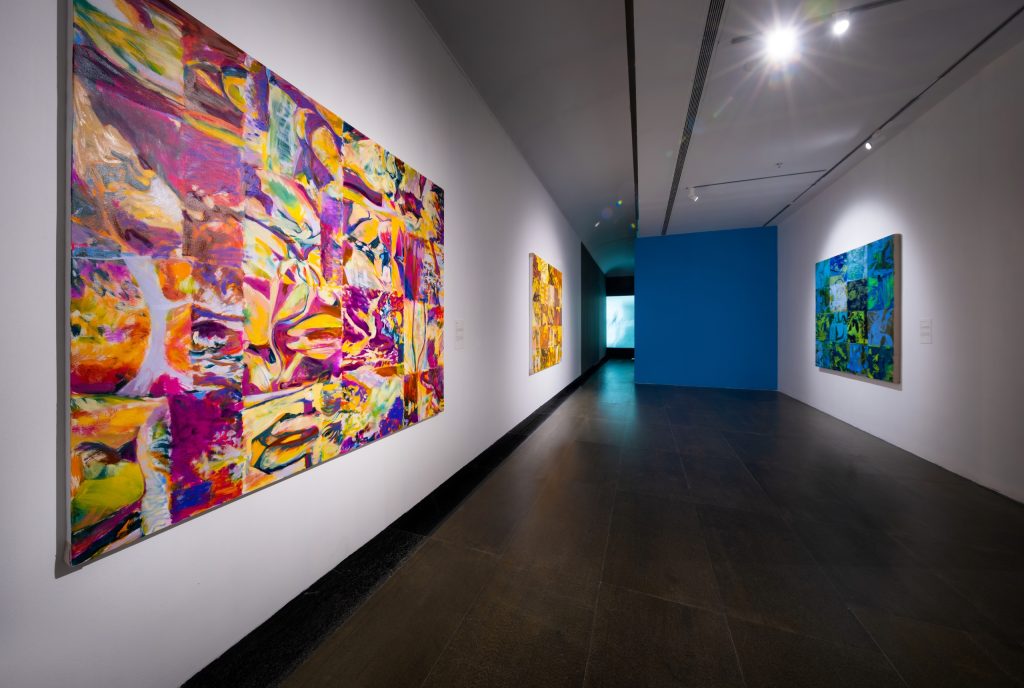
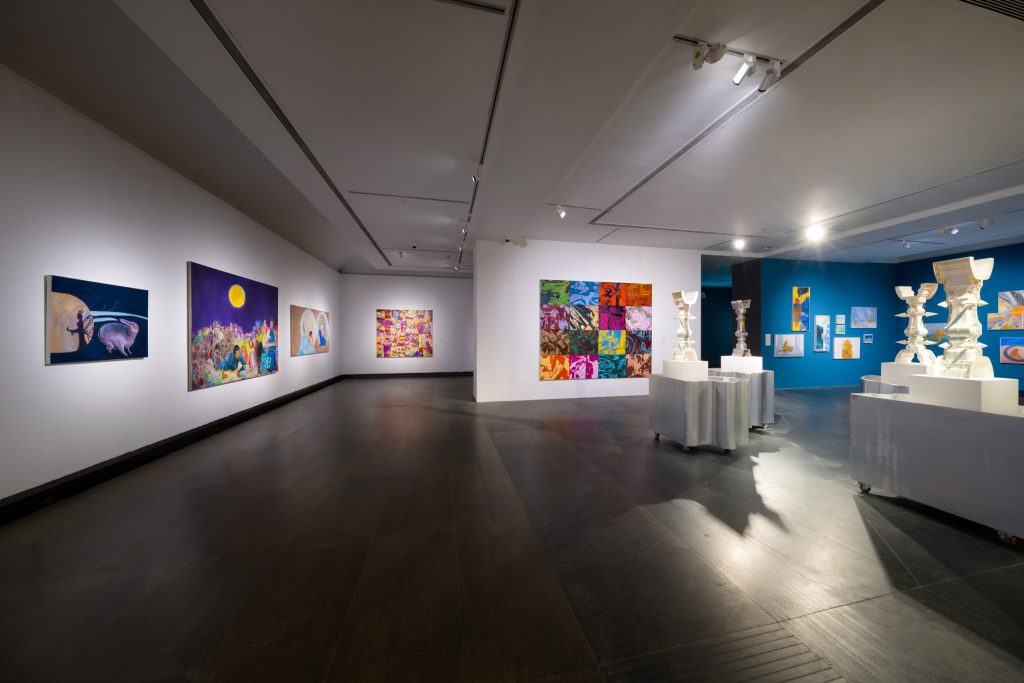
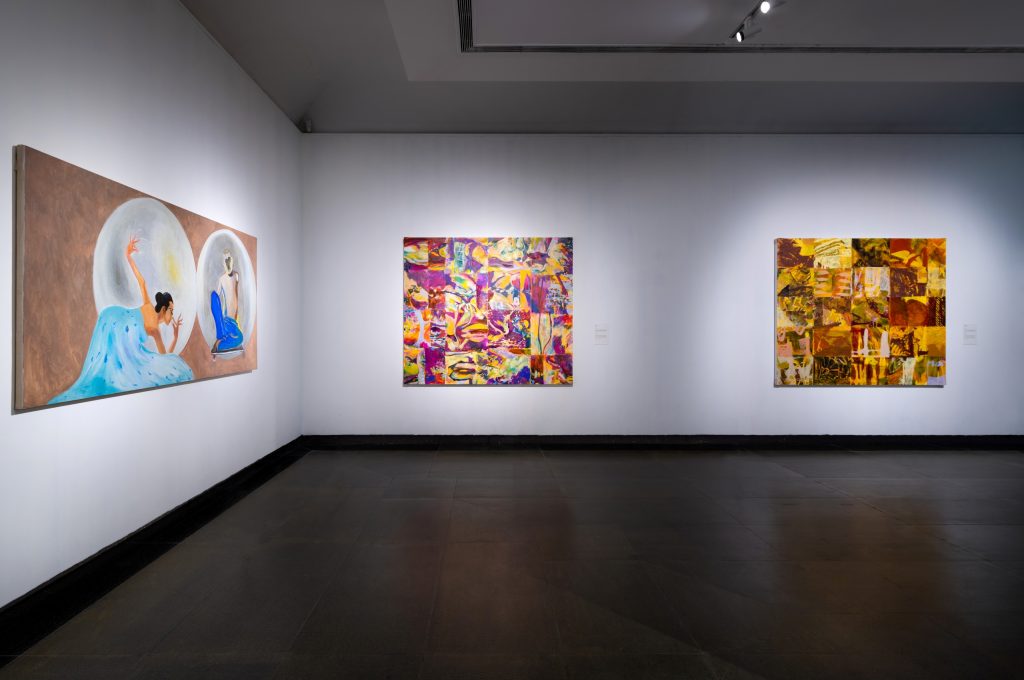
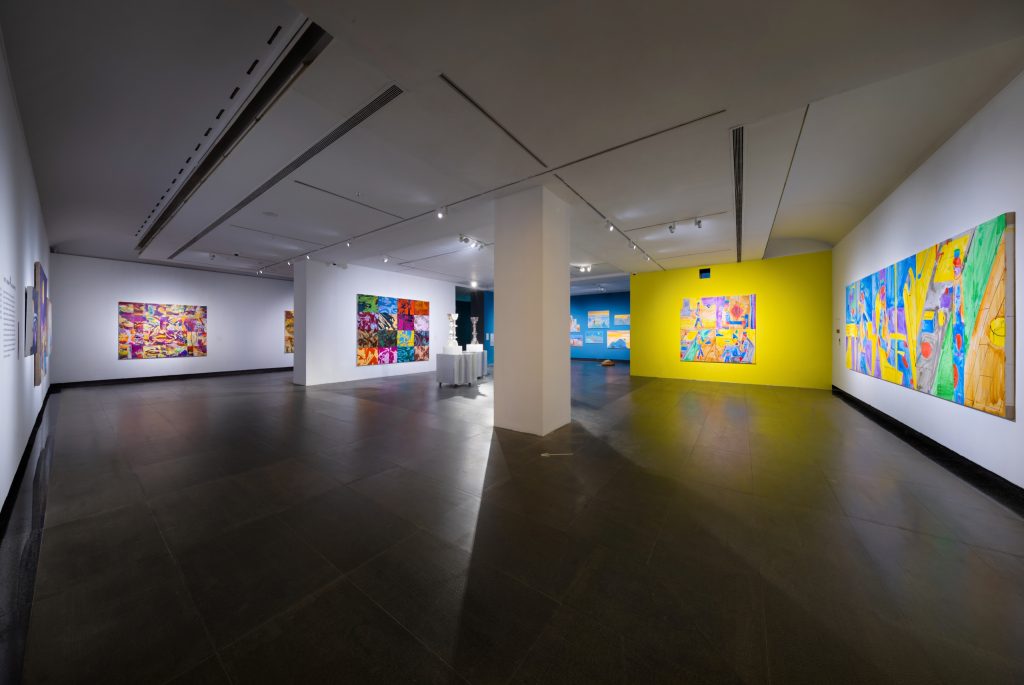
The 7th Guangzhou Triennial: Symphony of All the Changes, Guangdong Museum of Art, Guangzhou
广州三年展,广东美术馆,2023

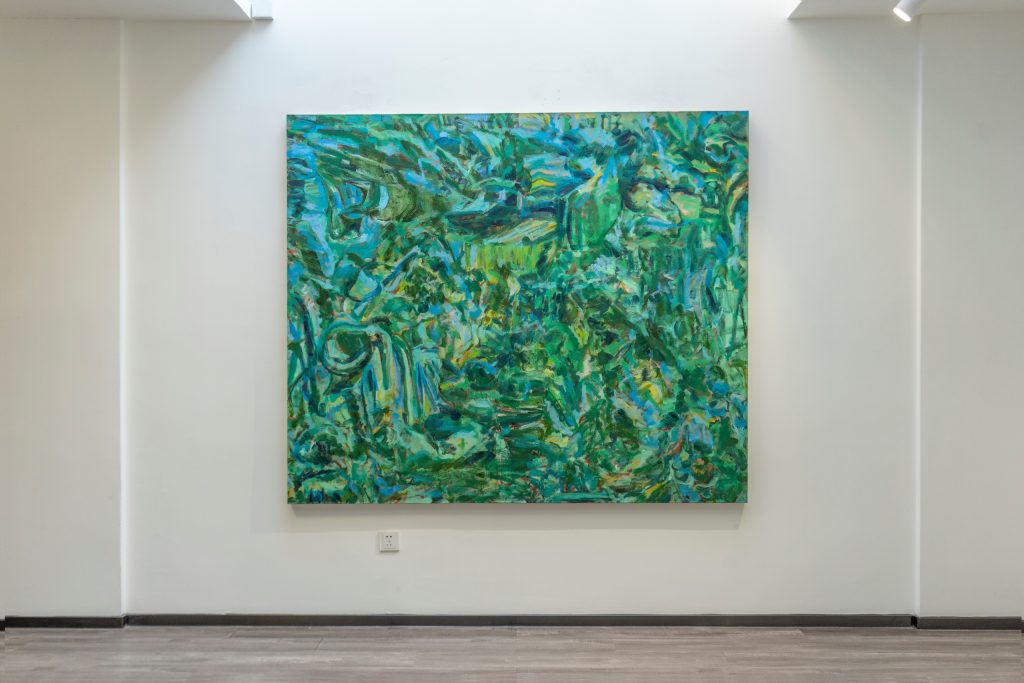
Heaven is a forest, One Atelier, Beijing,2023
天堂是一片森林,之谷空间,2023
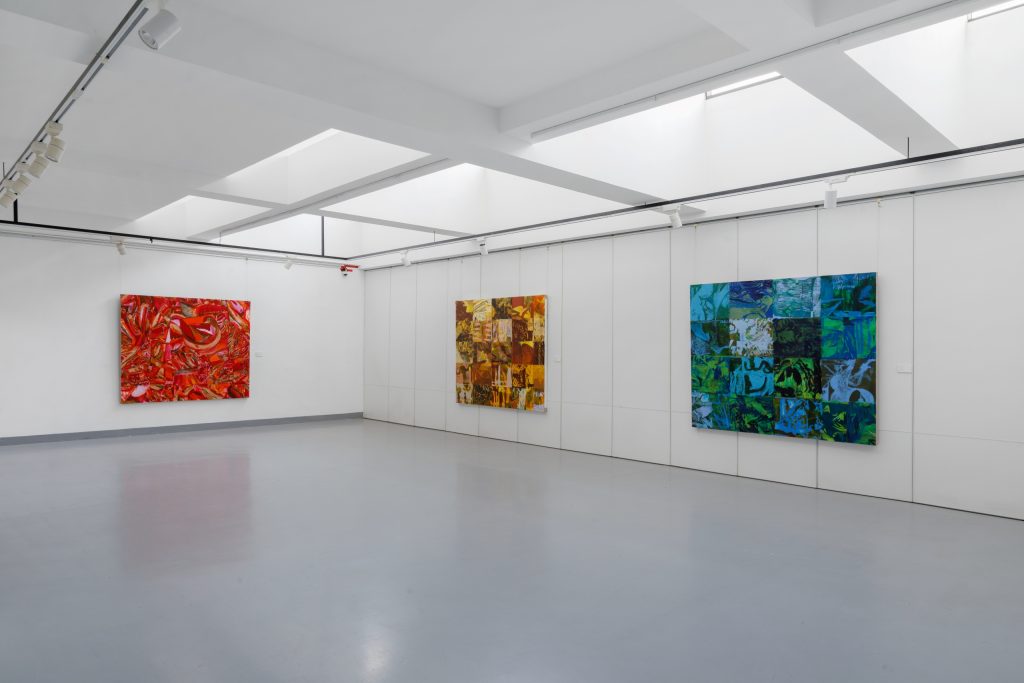
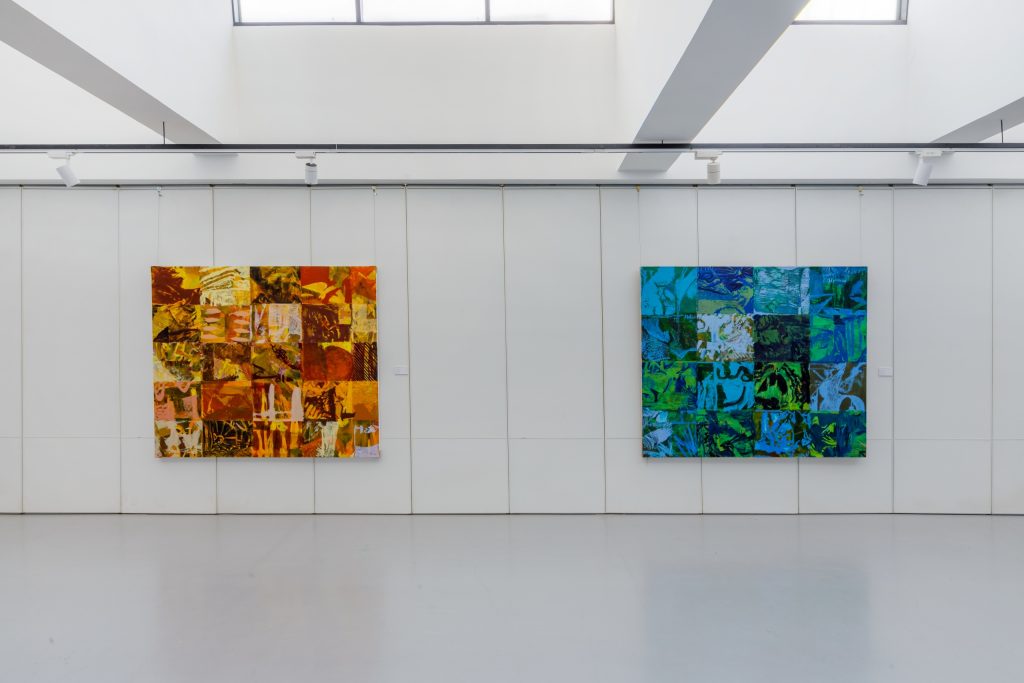
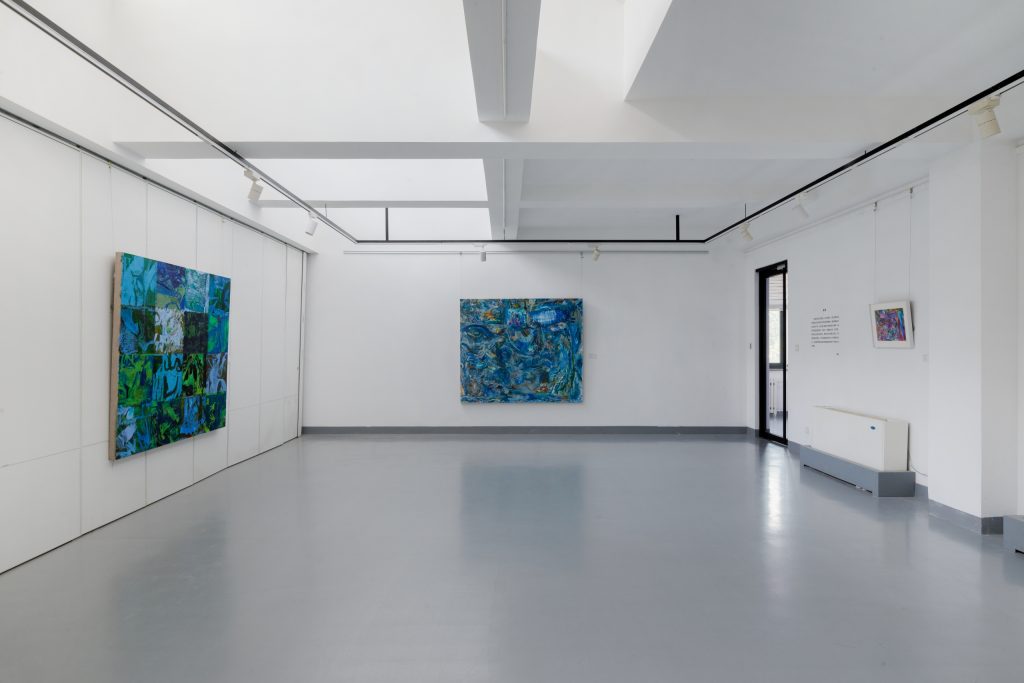
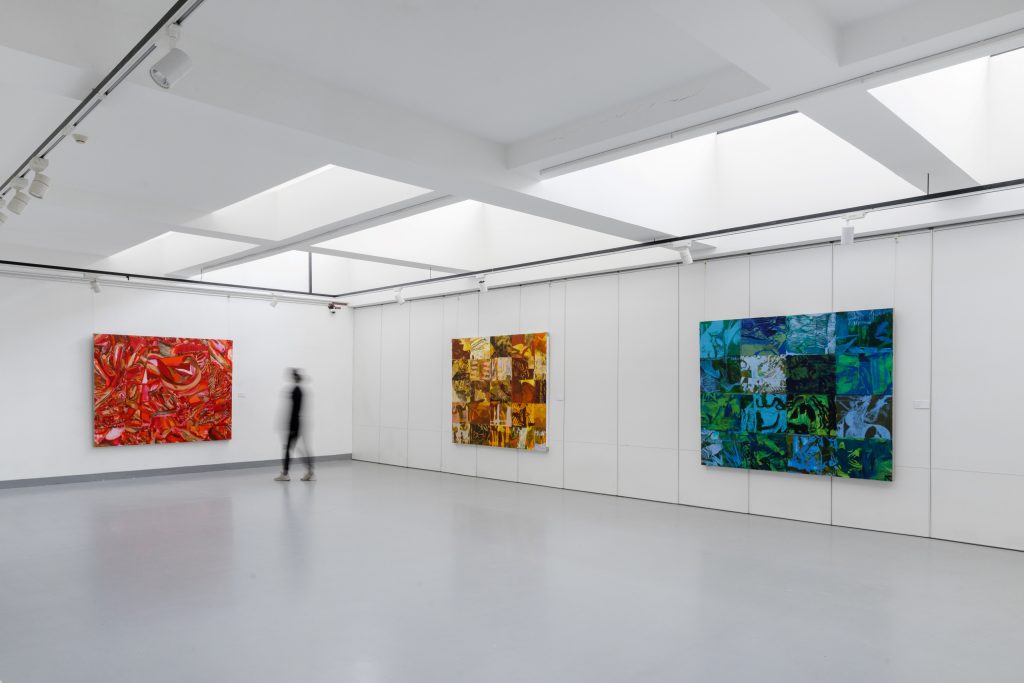
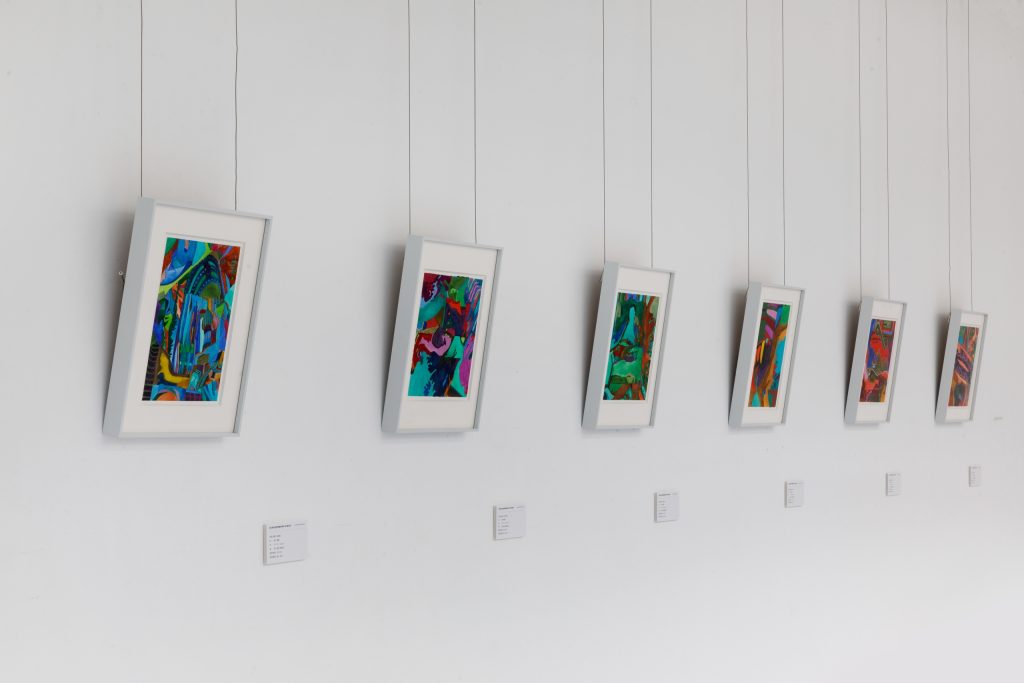
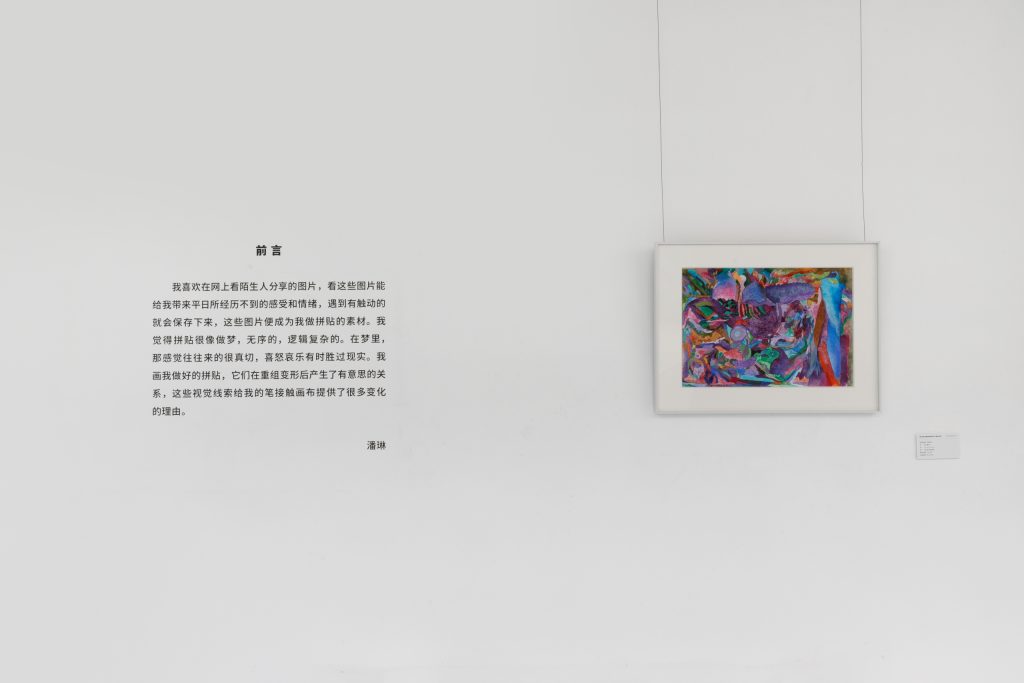
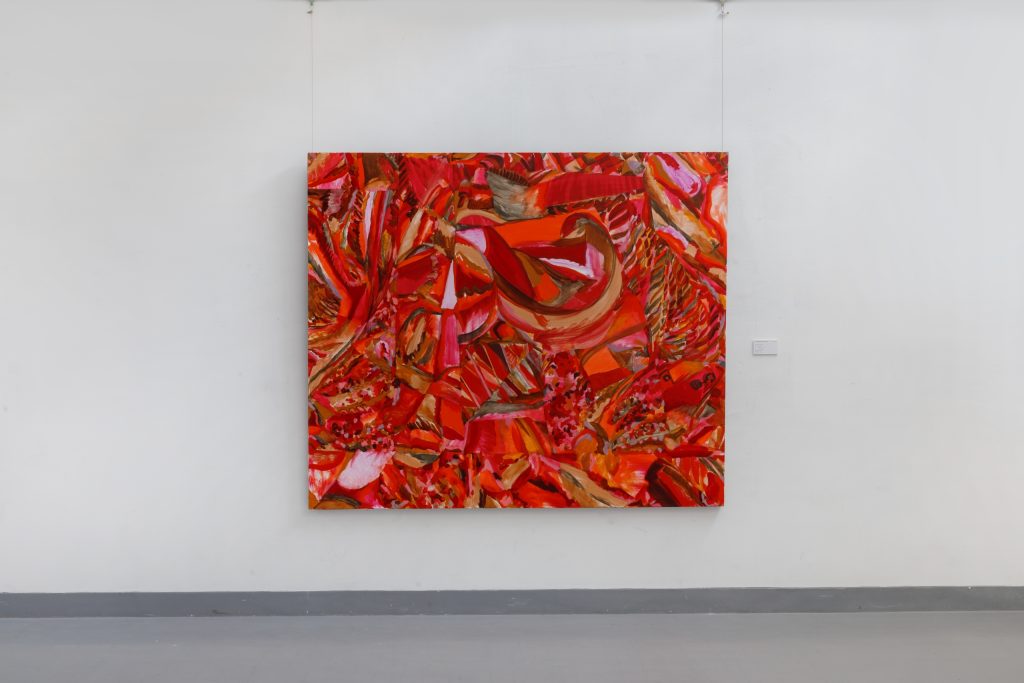
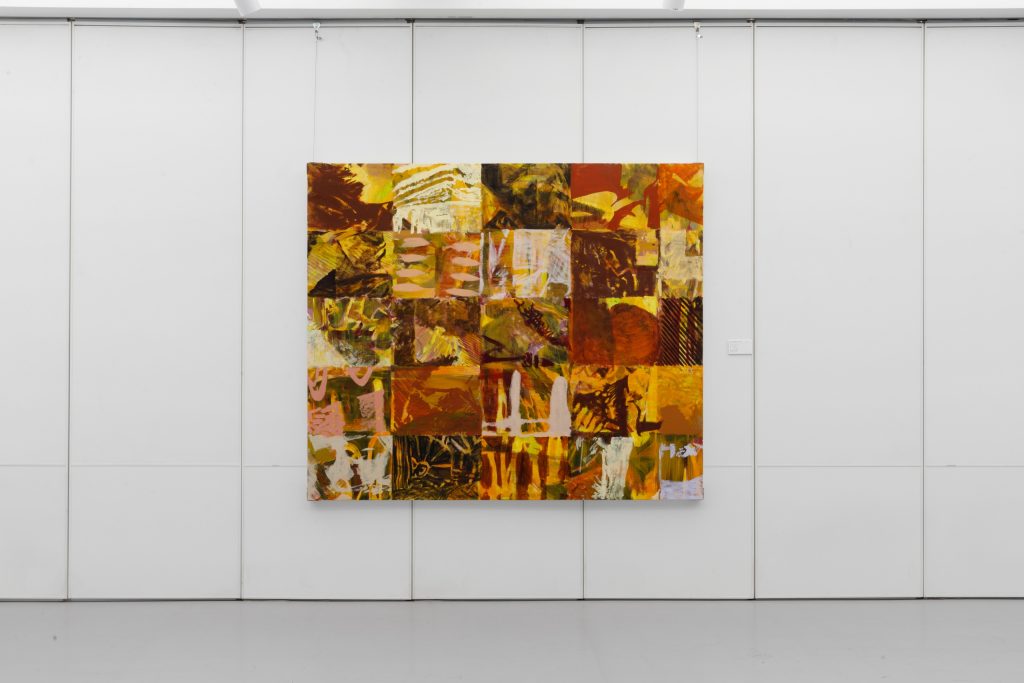
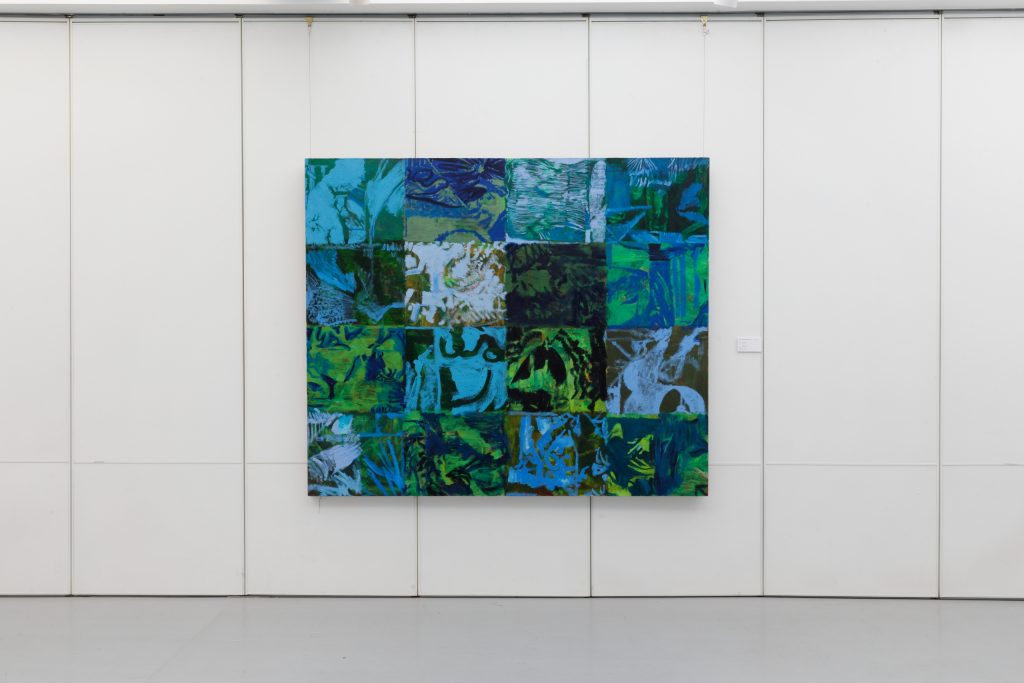
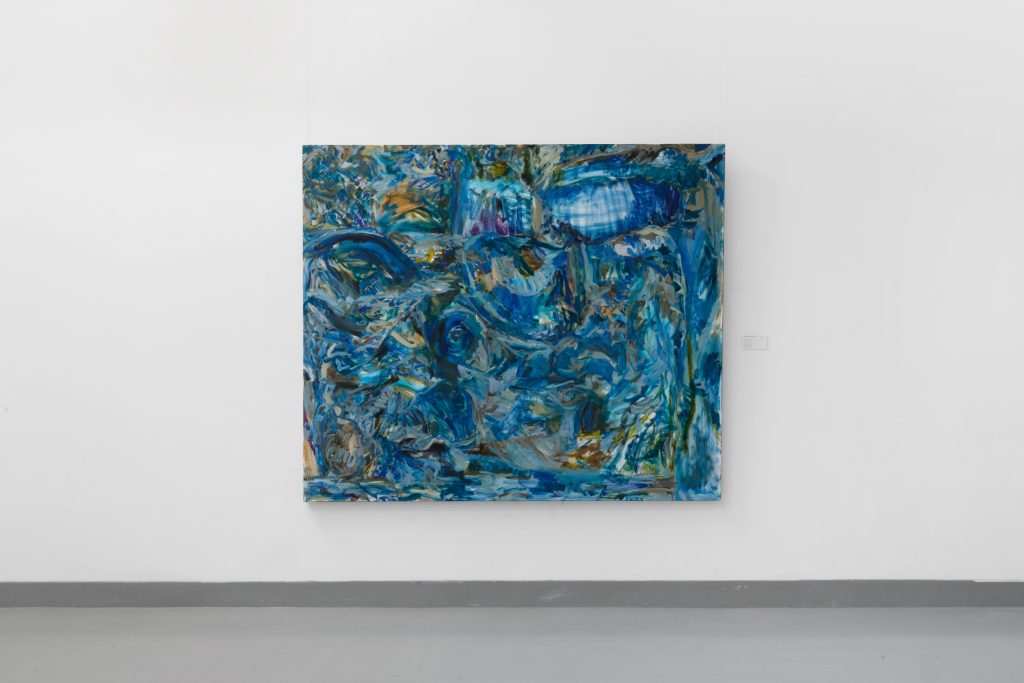
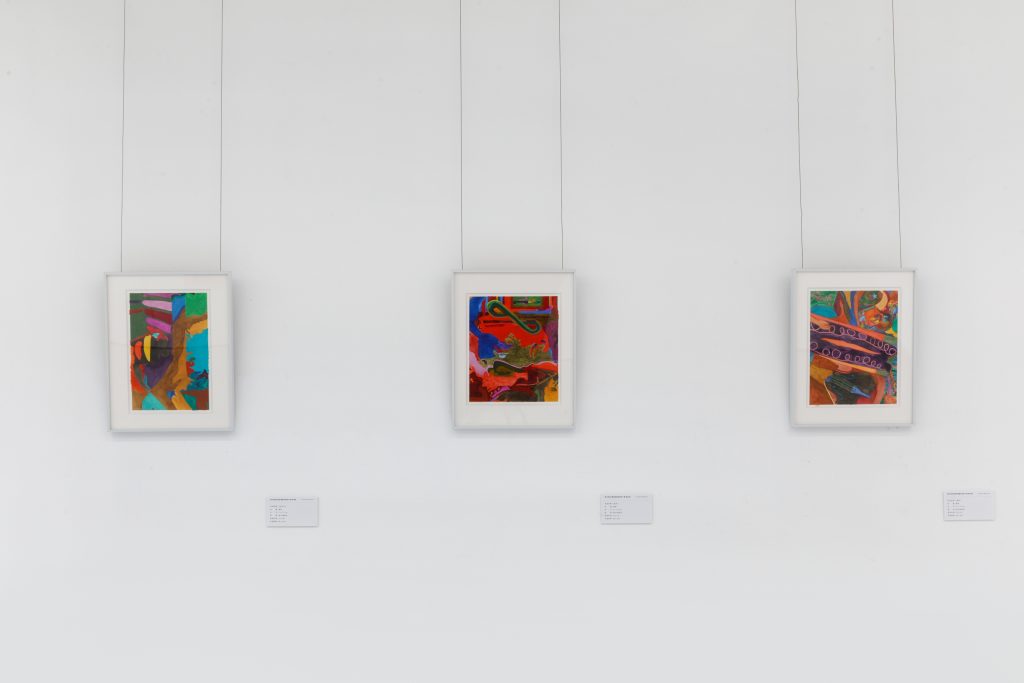
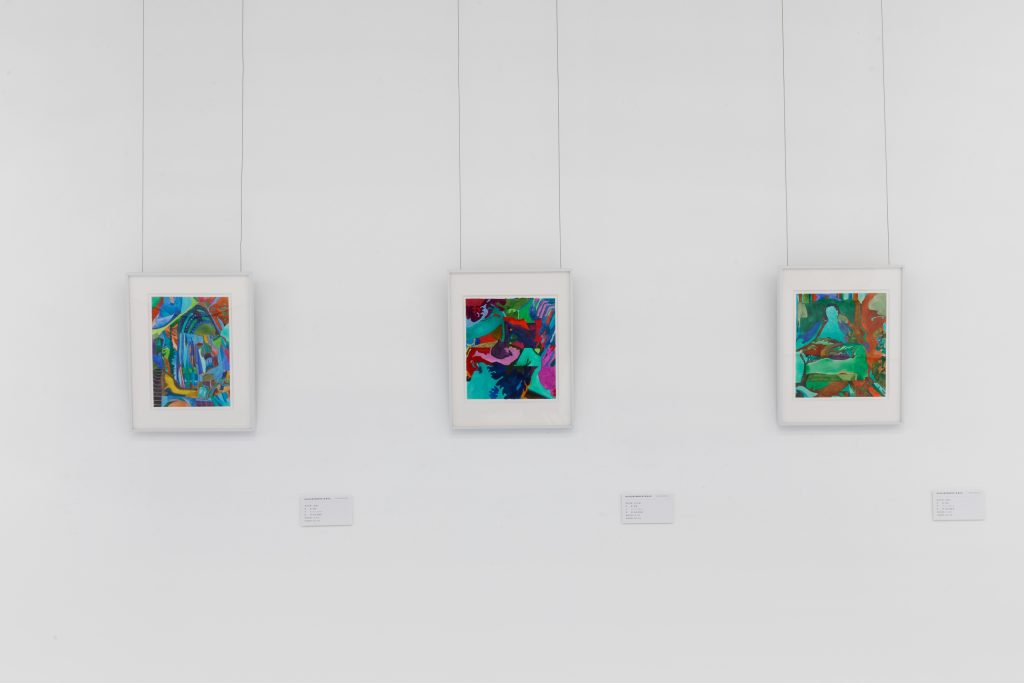
Multi-dimensional Sensibility, CAFA Art Museum, Beijing,2022
当下与传统双向激活,中央美术学院博雅展厅,北京,2022
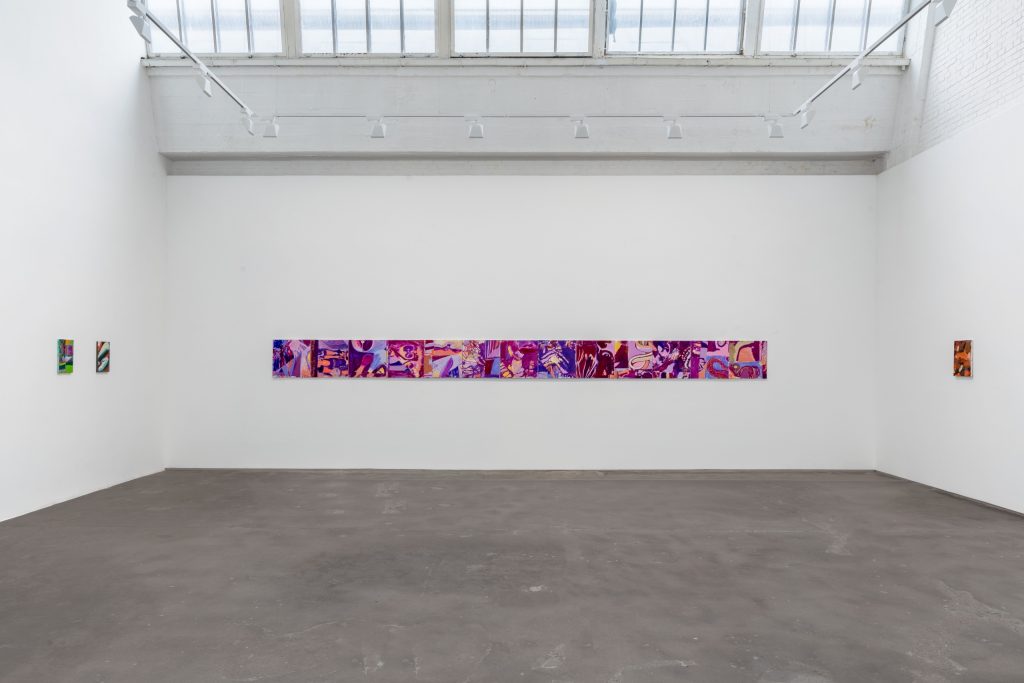
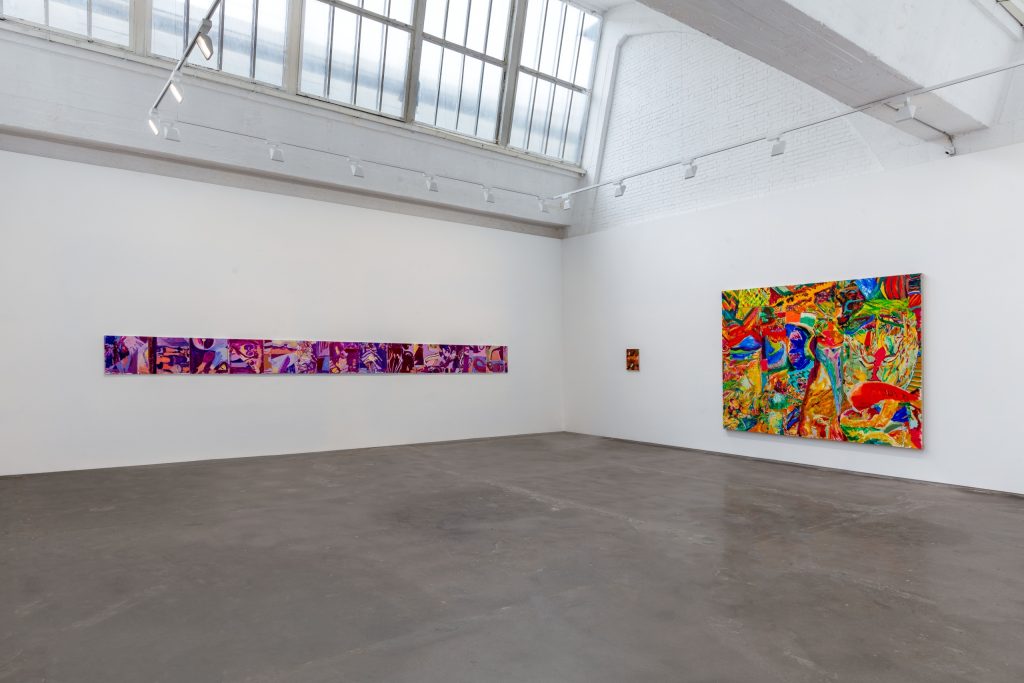
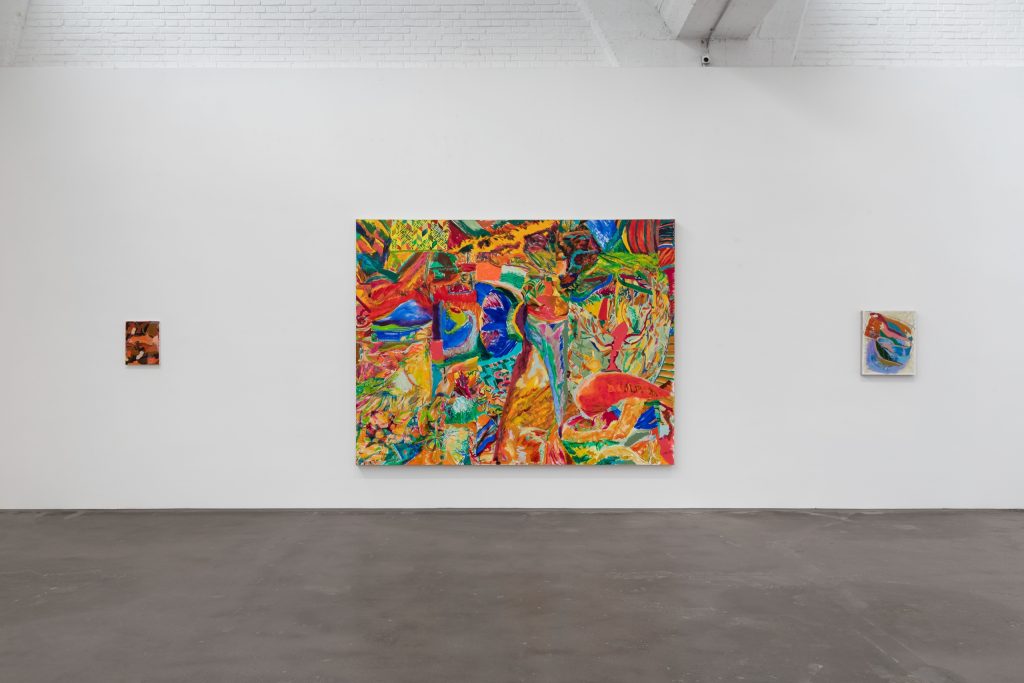
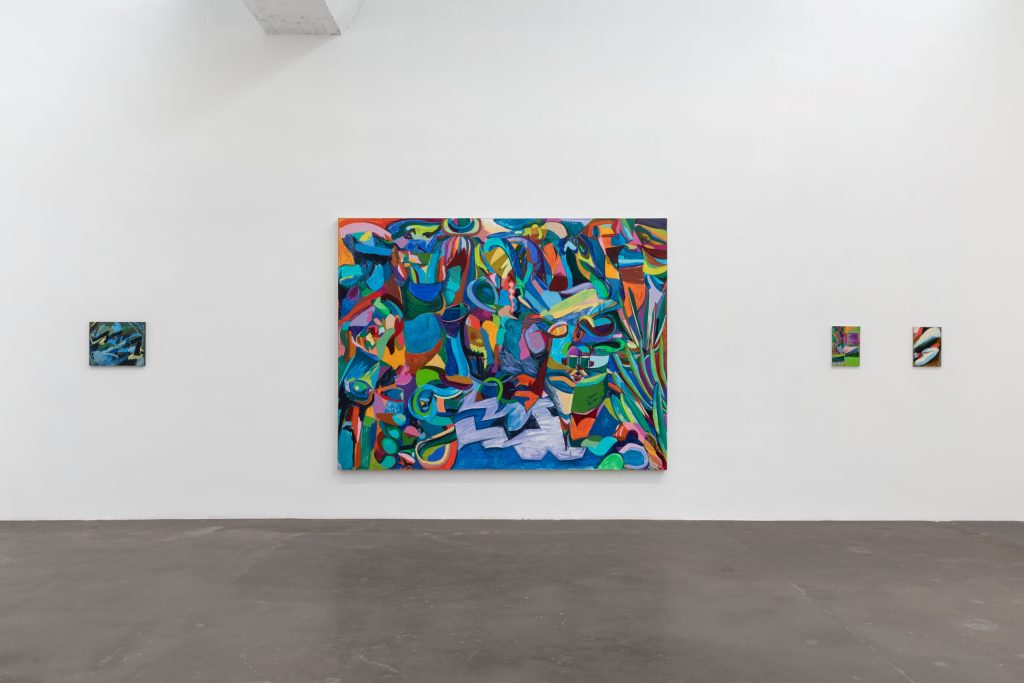
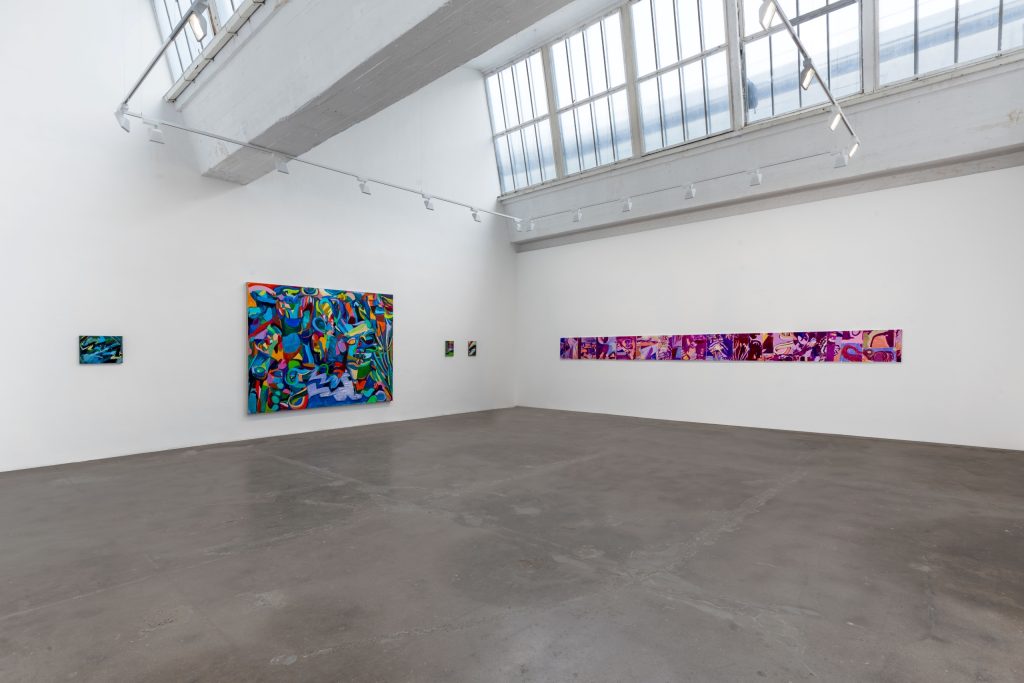
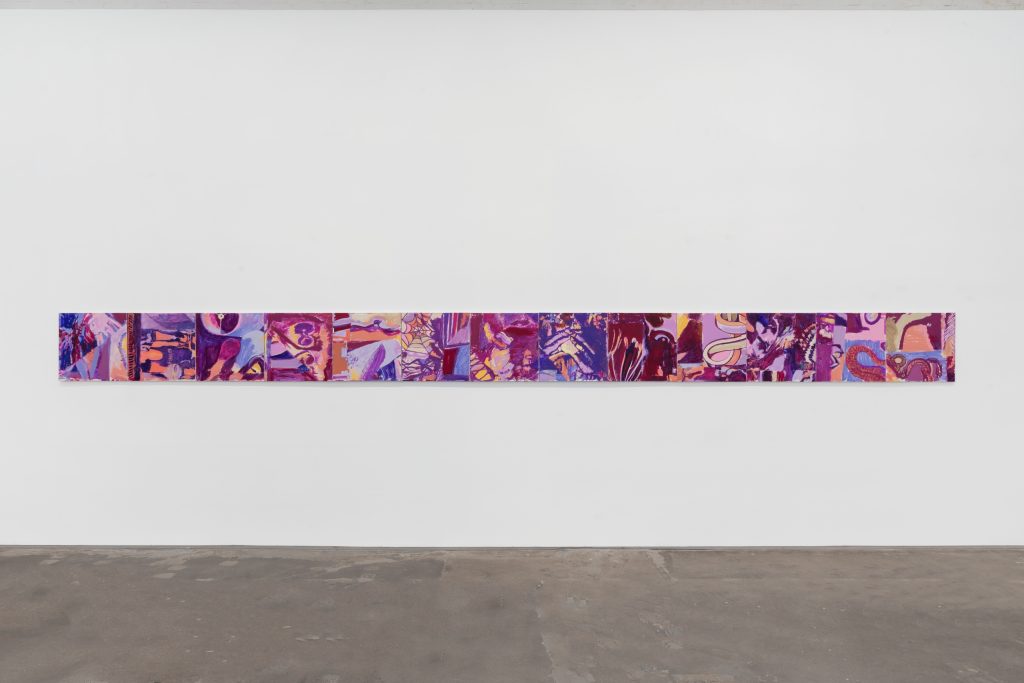
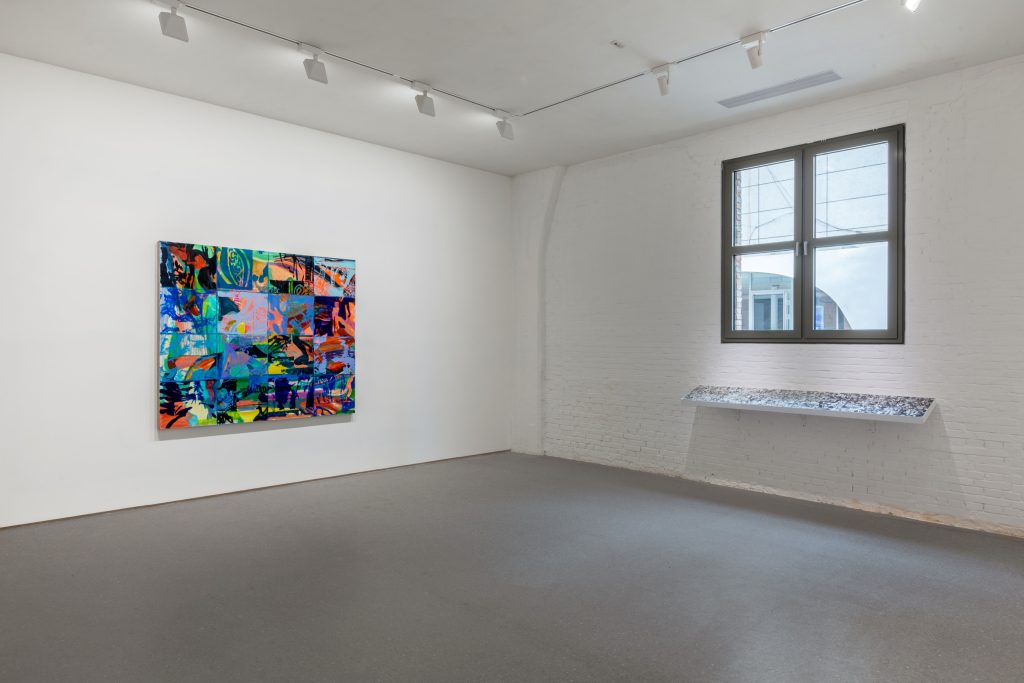
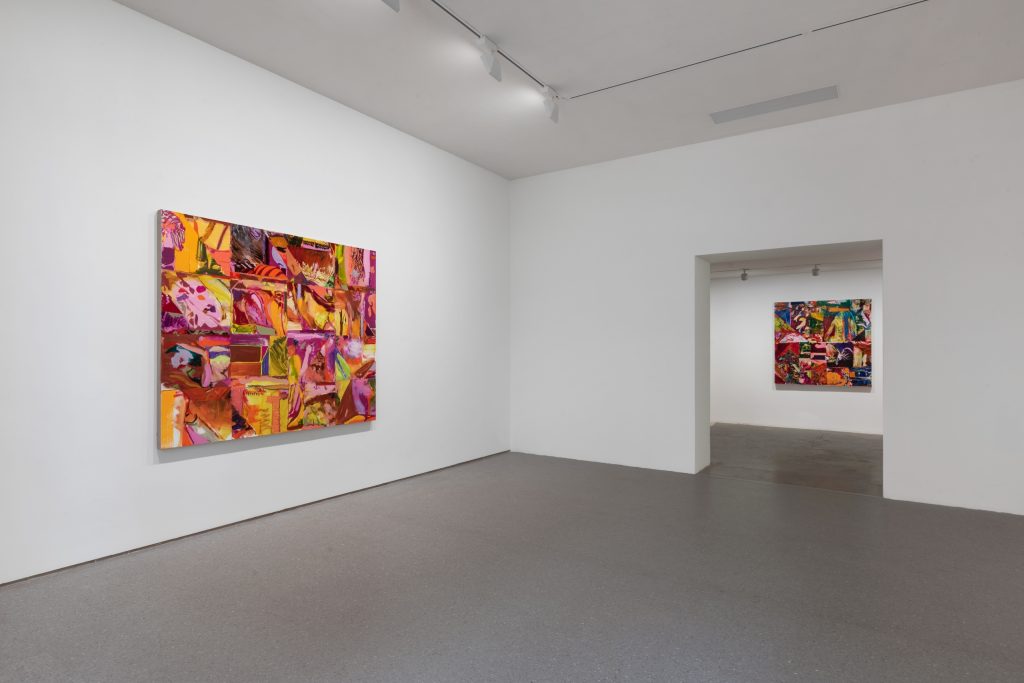
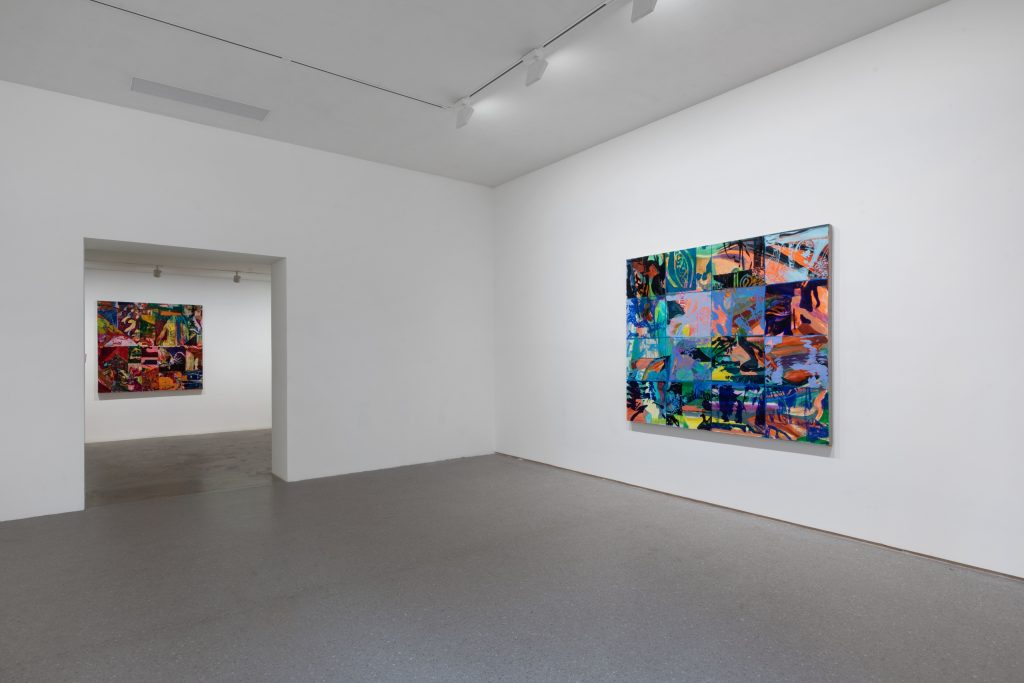
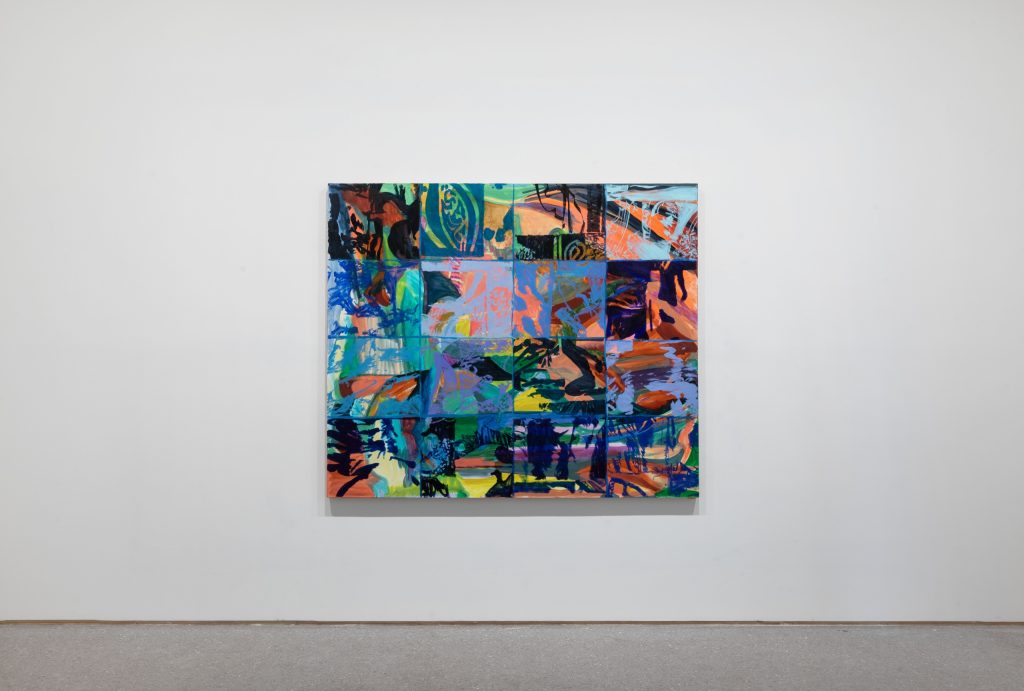
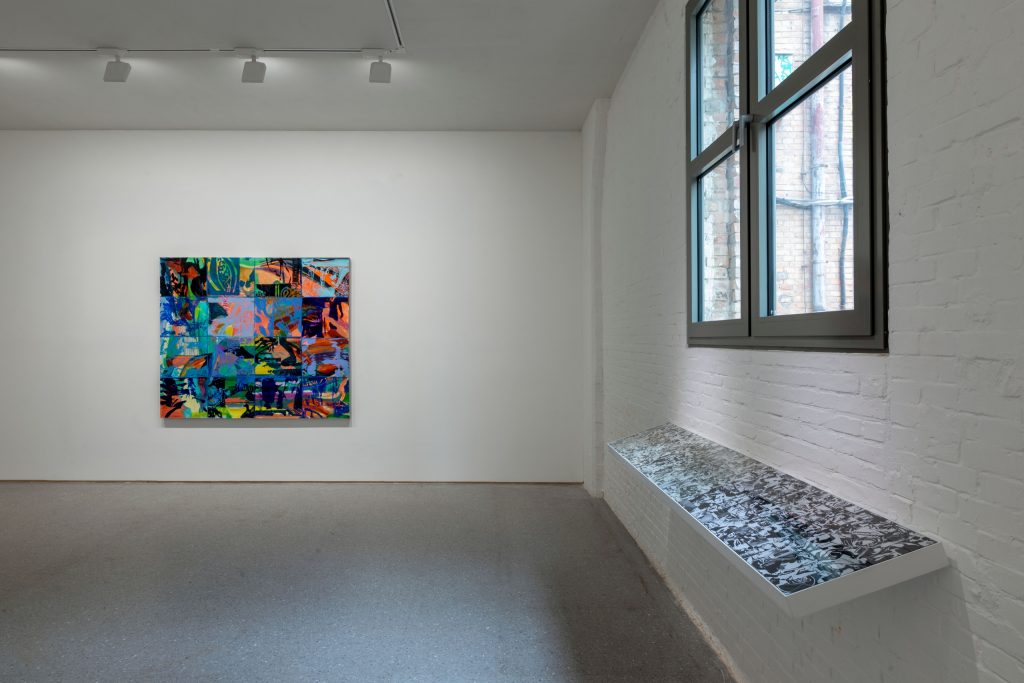
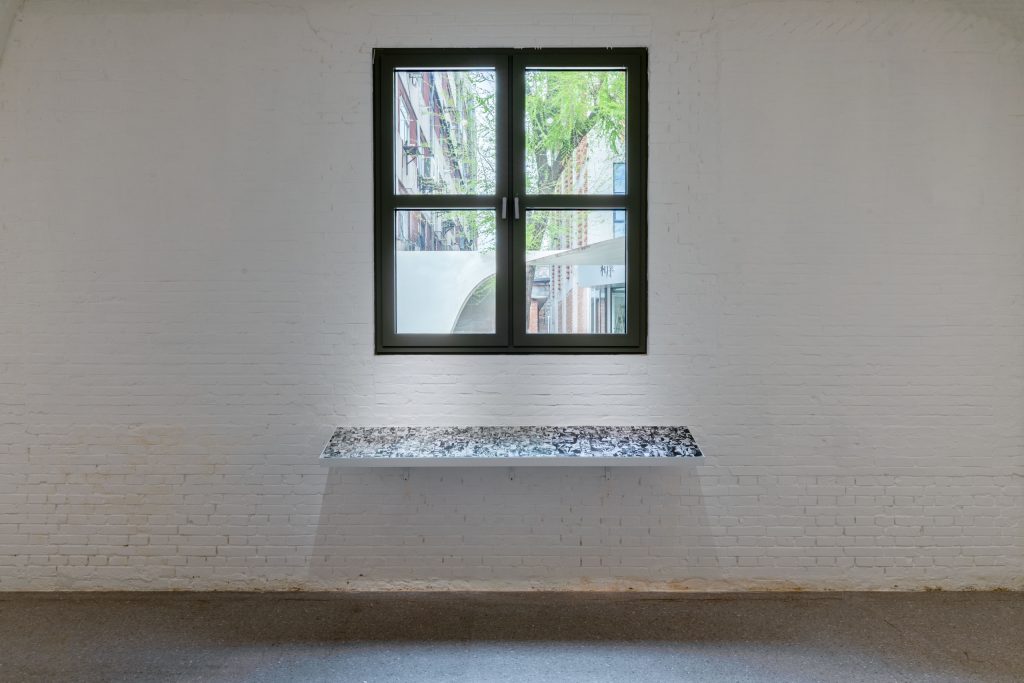
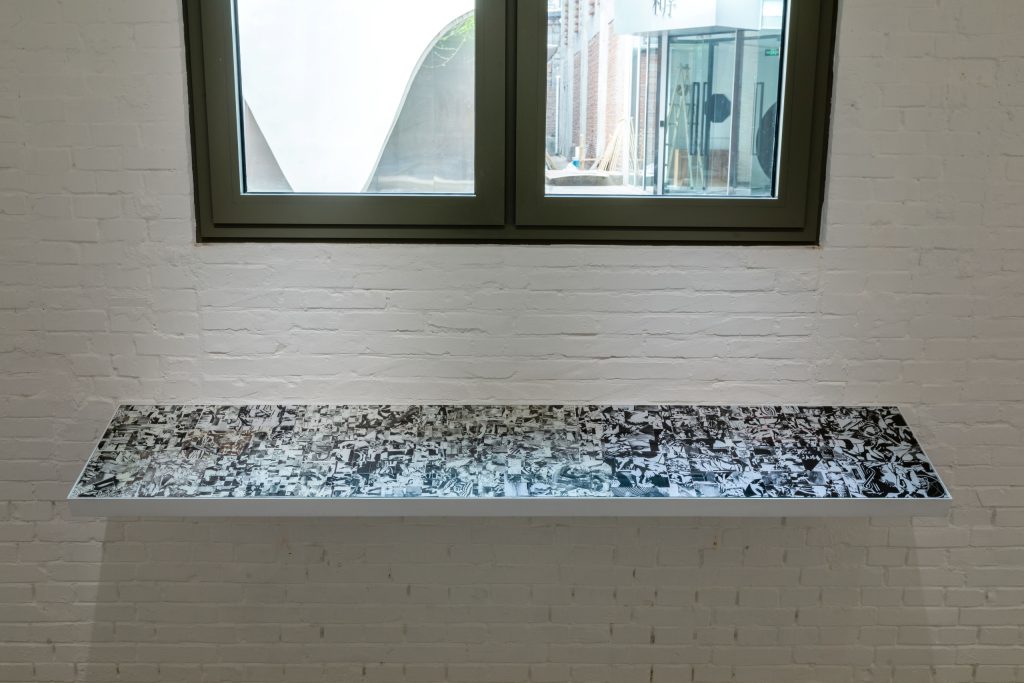
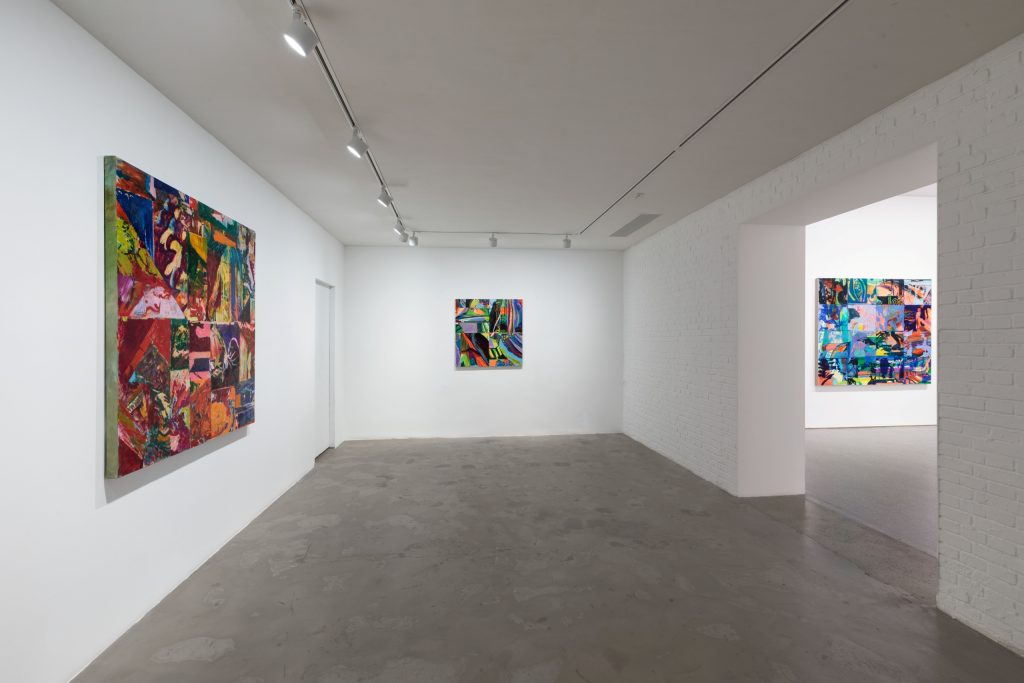
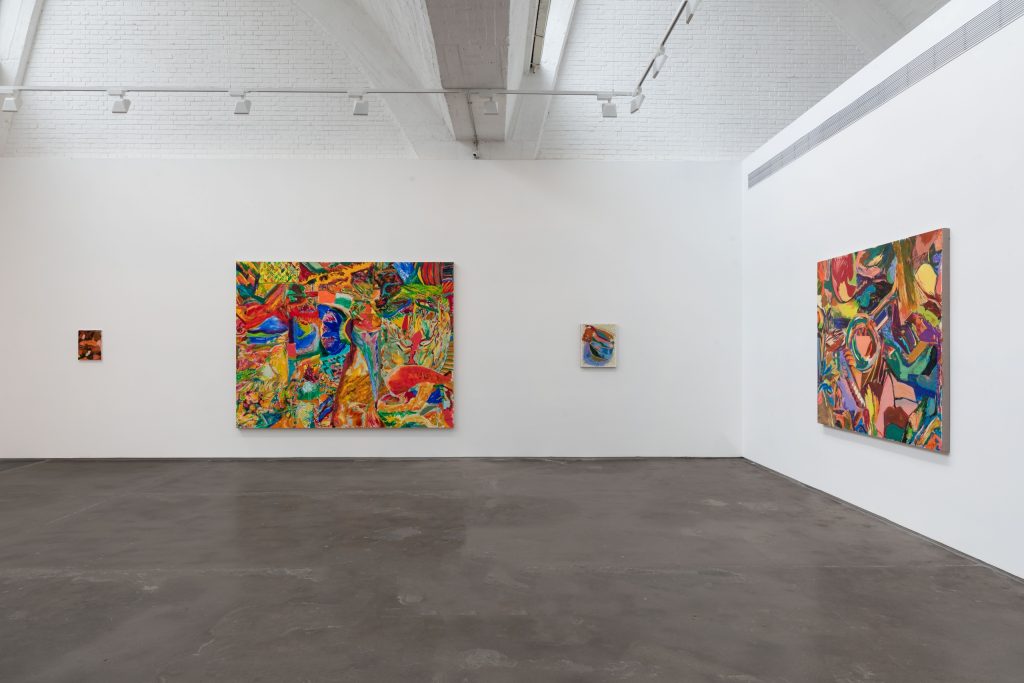
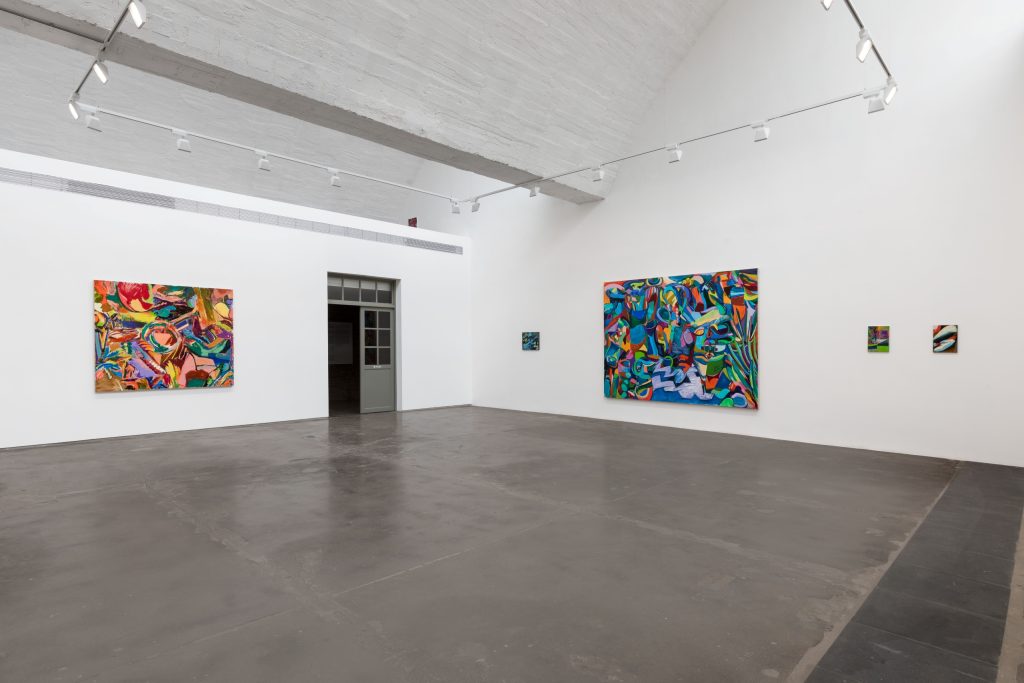
The Triumph of Colour, Star Gallery, Beijing
色彩的胜利,星空间,北京,2022
The Triumph of Color
From 9 April to 8 May 2022, Star Gallery presents Pan Lin’s solo exhibition: The Triumph of Colour. As the artist’s first solo exhibition with the gallery, it focuses on Pan Lin’s art practice over the past years, presenting an overview of her painting styles and themes. Pan Lin’s painting features intense colours conveying a whole new sense of energy while showcasing her distinctive painting vocabulary and styles.
Colors
We can see from Pan Lin’s work that, colors consist of the cornerstone of her practice, connecting the painted space and its structure. They are the origin of the artist’s creation as well as its finale. By playing with the colors, Pan constructs on canvas her spiritual sphere. When discussing how she understands color in painting, Pan admits, “Painting to me is probably more of a process to entertain myself, and creating imagery is a goal I set forth. I use color to achieve that goal and lay bare the process. When the imagery reaches the certain milestone that I have preset, and when I have sufficiently pleased myself, then the painting is finished.”
Since her early childhood, Pan has revealed a strong interest in painting—in elementary school, she took the initiative to study painting at the local “Children’s Palace,” where the district government set up extra-curricular activities for school-age children. After enrolling at the Xu Beihong Middle School, she began receiving formal training in both painting and the modeling of plastic mediums. She later attended the High School Affiliated with the Central Academy of Fine Arts (CAFA) and then the CAFA for her bachelor’s and master’s degrees. Following her training at the Academy, she enrolled in a graduate program at Boston University in the United States. Under the influence of this long path of academic art education, Pan’s skills in naturalistic rendering have developed into almost a reflex mechanism of hers. At the same time, this rigorous and rational training has become a challenge of certainty for Pan to work through. Pan finds the breakthrough in her color experiments; by experimenting with colors, Pan attempts to lighten the impact of her personal preferences and habits, in an effort to rediscover the state of beings at their genesis—in short, to start again the journey.
Pan paints between the tangibility and intangibility of the image: she pours out paint to enable the collision of color blocks on the linen and the twist and torque of lines under the brush. Every stroke of the brush is a challenge from spontaneity to her experience of rationality. Colors pierce through the painted tangibility of the object, and with her welcoming, open mind, Pan reconstitutes the image by reordering its colors. The colors are purified into their original hues, eventually converging on the befitting chessboard that is the linen canvas.
Collages
Pan Lin’s works are inspired by the images that she witnesses daily: a refreshing picture from online, a magazine page that Pan happens to flip through, a crisp label stuck to a cardboard box, a “decisive moment”… all media visible to the human retina could be the materials with which the artist works. In Pan’s paintings, what she sees daily concretizes into the basis of her collage work. The artist crops the materials she has collected, transferring and folding away the information pertinent to tangible forms, all to tear them apart later in a manner that cannot be pre-determined. Stability is deconstructed through this mechanism of spontaneous play, and the unrecognizable state of being becomes the artist’s starting point. For Pan, this is a special game: she does not intend to cut into pieces what she hopes to counter; rather, she tries to perforate them to endow them with more possibilities of meaning. As the artist herself has declared, “Actually, I have never given up figuration. Although all my current work appears abstract, in reality, they are very figurative, only that they have been cut into pieces… When an image is cut up or reversed in its orientation, it loses the figurative form that I would have normally imitated.”
In Pan’s collages, objects are still perceivable, and the disassembled images shall return to their undivided selves via their passage through fragmentation. Pan’s collage work is like picking up all the possibilities and occurrences in her life and tossing them back into the cycle, so they could reincarnate and happen again. She collages tirelessly, urging her objects to shed the shells that have been meticulously sculpted by contemporary media. She collages to bypass the externally assigned identities of objects, to re-pixelate and relink the realities that inadvertently coincide around her. Her collages bridge partition and convergence; arbitrariness and resemblance conspire together; the images dissipate in the aimless and directionless acts of cutting, piecing, folding, and combining, industriously mining the ever-greater potential of collage.
Proportions
There lacks an unambiguous focal point in Pan Lin’s work, as her work serves only the structure. Before making collages, the artist will first set up a structure—be it a checkered pattern, diagonals, or even an image of implied proportions. This sort of structure allows the pre-pictorial phase of collaging to dance with the chaotic world still under the rule of order: all daily fragments awaiting the touch of life will be linked by the chosen structure.
For Pan, the structure is to collage what proportions are to the pictorial surface—it is a chess game in which the artist plays against image and color, and it is also the inceptive manifestation of her painting practice. All elements on the painted surface coexist there at that very instant. In the dimension of aesthetics, proportions are not just a question of numbers, nor are they simple measurements or comparisons between lengths and widths. According to Plato, it is an investigation of how elements and patterns interconnect in and among various disciplines, as well as how we, as humans, perceive those patterns through our senses and power of intuition.
Pan’s game of collaging can be seen as an exploration that utilizes universal proportions to guide us in understanding the dynamic dance among creation, order, and chaos. This process starts with the artist’s summoning of different materials that sense and capture the world, and it moves on to the designation of rules and assignment of elements to fabricate a certain potential for heterogeneous production. Pan first shatters the various manipulable symbols, and then she regenerates her idiosyncratic imagery with an intuition that has unconsciously arisen. All sorts of fragments of experience, under the sensitive distribution of Pan, construct themselves into an autonomous field of aesthetics. Familiarity and strangeness become one, while intuition and reason go hand-in-hand; proportions rid themselves of the distraction by themes, gaining a firm grip on the essence of beings by establishing their self-rule—thus, they harvest freedom and liberation. Thanks to the fusion of proportions, images manage to maintain the similarity among them, casting behind their previously prescribed physical characteristics. They again realize their potential to reach infinity and thereby appear comfortably on canvas. It is because of the proportions designed by the artist that the painted colors and images seem as if they are at home, and such is not a coincidence.
Just like that, by collaging (redistributing and expanding) the images that she sources from her day-to-day life while studying and experimenting with colors, Pan shakes off the limitations originally imposed on the images and calls forth a passion for free will and the authentic self. As the artist says, what she prefers is the act of painting. The artist frees the act of painting from existing demands, turning it into the game of collaging—a great adventure of the artist’s reason in the face of a bewildering world filled with stimuli. In the coexistence of acts of dismantling, assigning, and generating, time becomes suspended, only to be complemented into innumerable wonderful images by countless glittering moments.
Introduction by Guo Xiaohui
Translation by Jacob Zhicheng Zhang
色彩的胜利
2022年4月9日-2022年5月8日,星空间呈现艺术家潘琳的个展:色彩的胜利。展览聚焦艺术家关注的创作线索,对艺术家近年来的创作实践进行了集中呈现,展示出艺术家绘画创作风格和主题的演变。正如标题所示,潘琳高纯度色彩的绘画为我们展现她独特的绘画语言和风格的同时,也带来一种全新的能量。
色彩
通过潘琳的作品我们可以看到,色彩显然是艺术家创作的基石,连接起了作品的空间与结构,它既是艺术家创作的缘起,亦是作品展现的结局,通过跟色彩的博弈,潘琳在画布上构建起一个属于她自己的的精神世界。在谈到她如何理解绘画中的色彩时,潘琳表示,“画画可能更多的是娱乐自己的过程,图像就像是我设定一个目的,然后我用色彩去达到这个目的,来展现出这个过程。当画面达到某一个我预设的点,我自己被愉悦到了,就可以停止了。”
潘琳自幼年时就显示出对绘画的强烈兴趣,上小学时她就主动要求去少年宫学习画画。后来考上徐悲鸿中学,开始系统地接受正规的绘画和造型训练,接着考入央美附中,之后考入中央美术学院,学士毕业之后接着读了研究生,再之后又去美国波士顿大学就读研究生课程。在这种传统的学院式的艺术教育的影响下,她的写实功夫的训练已经形成了手和脑的直觉式反应,但这种严谨的理性训练对潘琳而言,同时又成为突破确定性的一种挑战。潘琳从她的色彩实验之中找到突破口,在各种尝试过程中,潘琳尝试消抹掉自身喜好与惯习的作用,重新发现事物之初所具有的状态,再重新出发。
颜料倾注而出,色块在亚麻布上相互碰撞,线条在笔刷下扭转,潘琳在图像的有形与无形间作画。每一次落笔,都是她的理性与经验与随机性的挑战,有形的物体被色彩所贯穿,潘琳以全然接受的开放和自由心态,重新分配图像和色彩,颜色纯化为颜色本身,它们将全部汇集在恰如其所是的画布棋局上。
拼贴
潘琳的艺术创作灵感来自于她日常所目睹的图像,网站上眼前一亮的图片、杂志上偶然翻到过的一页、纸壳纸箱上干脆利落的标记、生活定格的一瞬间……她所触碰到的一切含视网膜因素的媒介都有可能成为艺术家的素材。在图像里,日常生活中的所见成为了拼贴的基底。艺术家裁剪她所收集到的材料,转印和折叠有形可见体的信息,以一种不可指定的方式重新把它们拆解开。在这种随机自由的机制中,稳固性被解构了,不可识别的状态自然就成为艺术创作的出发点。对潘琳而言,这是特别的游戏,她并非是剪拼所想要对抗的东西,而是试图穿透它们而重新赋予它们更多可能性。就像艺术家本人所说,“其实我一直也没有放弃具象,现在所有的画都是看似很抽象,但实际上特别具象,只不过它们是被剪成了碎片……当图像被剪碎了,或者调转方向以后,它失去了我原本会自然去模仿的形象。”
在拼贴之中,物体依然可感,拆分后的图像也将在碎片化的状态中回归未分化的全然整体。潘琳的拼贴工作就好像是捡起她生活的所有已发生的可能与生成,再把它们重新掷回未发生的可能性之中。她不厌其烦地剪拼,使具体事物褪下被现代传播媒介所细致描摹过的外壳,绕开外界赋予的客体身份,以重新像素化的方式,重新勾连起那些不经意间相会在她身边的实存。潘琳的拼贴连接起了区隔和汇合,随机性与相似性合谋,图像弥散在无所求取,亦无所强制的艺术家的剪、拼、折、合中,并孜孜不倦地开发着它更大尺度的潜能。
比例
潘琳的作品中没有一个明确的视觉焦点,她的工作机制是结构本身。在做拼贴之前,艺术家都会预先设置好一个结构,它可能是格纹,也可能是斜线,甚至是一种隐含着的比例。这种结构使得绘画前期的拼贴实践始终在秩序统御下对混沌未明的世界发起邀约:一切等待着焕发生机的生活碎片都将由结构串联。
对潘琳而言,结构之于拼贴,就如同比例之于画面,是艺术家与图像和色彩对弈的棋局,也是她绘画实践的最初显现——画面上的所有元素都在彼时彼刻共存于此。比例在美学这个维度而言,不只是一个数字的问题,它也不是相对于整体而言的简单的测量和尺寸的比较。根据柏拉图的说法,它是对元素和模式如何在各学科之间连接和相互联系的调查,是对我们作为人类如何通过感官以及直觉来感知这些模式的调查。
潘琳的拼贴游戏可以看作是一种利用普遍的比例来指导我们理解创造和秩序与混沌之间的动态舞蹈的探索。这个过程从艺术家集藏感知世界的各种素材,到划定规则、分配元素,来制造出某种异质化生产的潜能。她首先打碎了各种可操作的符号,又以一种无意识生发的直觉重新生成她独有的图像。诸种显示经验的碎片在潘琳的感性分配下自我建构出了一个自主的审美场域。熟悉与陌生融为一体,直觉和理性共同作用,比例挣脱了内容之纷扰,依靠自身的主权掌握住了本质,从而获得自由和解放。得益于比例的融合,图像无拘束地保持着它们之间的相似性,也遗忘了过去被规定的物质个性,重新实现了自身的无限性,并安然落在画面之上——也正是由于艺术家所创造的比例排布,确凿证实了画面中色彩和图像自身的“恰如其所”绝非偶然与巧合。
就这样,潘琳利用她日常收集的各种图像通过拼贴来重新分配与拓展,并通过对色彩的研究和实验,甩脱了其本来的限制,在画布上构建起一个属于她自己的的精神世界,召唤出对自由意志和本真的热情。就如艺术家所说,她更多喜欢的是绘画这行为本身。画画这一动作在艺术家这里摆脱了它固有的要求,变成潘琳正在进行的拼贴游戏,也是其理性面对茫茫混杂的感性世界进行挑战而进行的伟大冒险。在拆解、分配与生成的共在中,时间暂停在瞬间,并以无数个闪耀时刻补足了无数个美妙的画面。
撰文/郭小晖
翻译/张至晟
